A visit to Trinity Site (where the first atomic bomb exploded )
Trinity site open house, locations to visit, trinity test site (ground zero), other locations to visit, a brief history of the trinity site, useful links, now it is your turn.
This is a complete guide to visiting Trinity Site. In today’s guide you’ll learn:
- How to get there
- Before you go
- Every location to visit
In short: if you are planning a visit to Trinity Site, you’ll love this new guide.
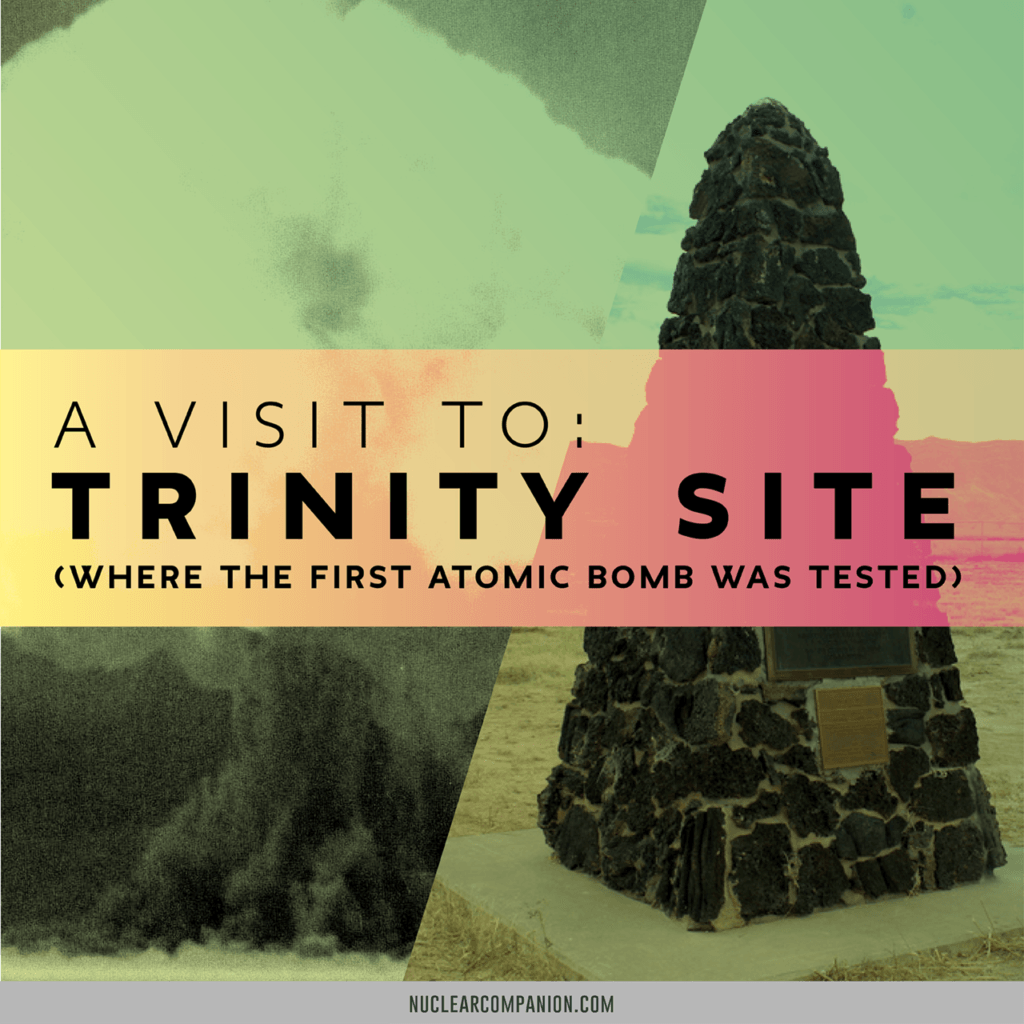
Trinity was the code name for the first test done on a nuclear weapon. Today, it also refers to the geographical area where the test occurred in the Jornada del Muerto (“Journey of the Dead Man”) desert in New Mexico. If you are interested in visiting the site, first understanding the history behind it will help to enrich your experience.
Please understand that the only time you can see the Trinity test site is on open house days, which occur twice per year. Military leaders oversee the open houses. Stationed nearby the base, they offer an immersive experience into understanding the importance of the Trinity site.
White Sands Missile Range (WSMR) is an active military site. Much of the site is closed to the public because it is within the missile impact zone.
Open houses only occur twice per year, on the first Saturday of April and October . As you can imagine, thousands of people come to the site on these dates to take part in the open house, so you need to plan your trip well in advance. The open house is from 8 am until 2 pm, so it is a full day with a lot of learning experiences built into it.
Suggestion: Get there early If you don’t like fighting a crowd and long lines for everything, get to the Stallion Gate at 7:00 AM or 7:30 AM before the site opens at 8:00 AM.

How to Get There
The Trinity test site is located at the White Sands Missile Range, off of Highway 380 in White Sands, New Mexico. Keep in mind that if you want to visit on an open house day, you will need to plan to go either on the first Saturday of April or the first Saturday of October. Those are the only two days each year the tour is available.
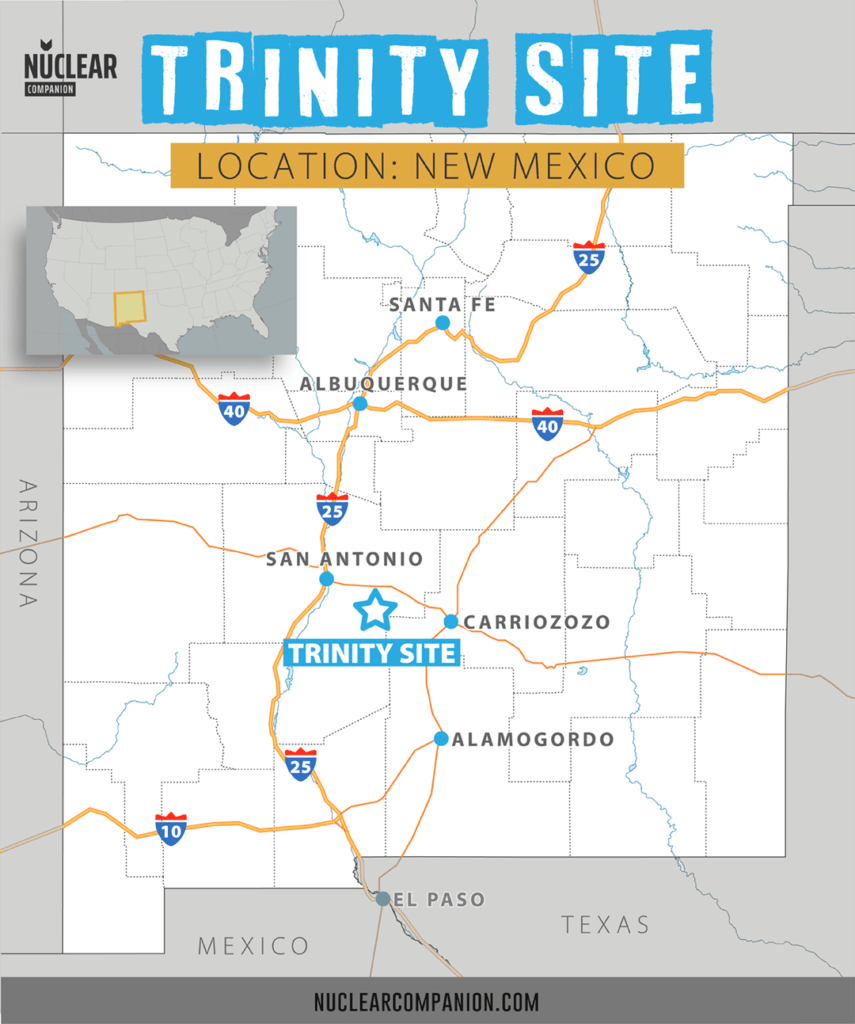
White Sands is not a city but rather a census-designated place (CDP), meaning that you will find residents but very few amenities, such as restaurants and hotels. If you need a place to stay overnight, you will probably want to make reservations in Las Cruces, which is about 27 miles west, or another nearby city.

To get to the Stallion Gate Entrance from San Antonio, New Mexico, take Exit I-25 on mile marker 139 and travel 12 miles east. To get there from Carrizozo, take exit Highway 54 onto Highway 380 and head west for 53 miles. From the Stallion Gate Entrance, you will go another five miles off the highway. It is easy to follow because the site is marked clearly from Highway 380.
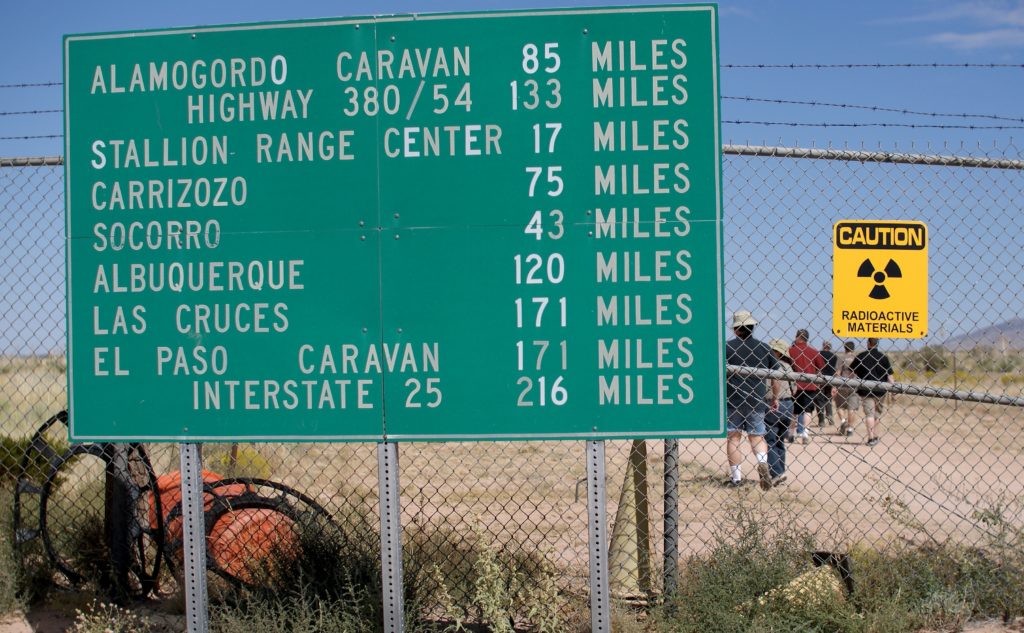
Today, the 51,500-acre site that composed the test site is a National Historic Landmark. Included in the landmark are the McDonald ranch house, Ground Zero, and the base camp. If you go on an open house day, you can see Ground Zero for yourself. This area includes the bomb casings known as “Jumbo” and “Fat Man,” historical bunkers, and parts of the crater left by the explosion. The element created as a result of the blast, Trinitite, is also on display.
Before You Go
Please understand that even though the test site is a tourist attraction and National Historic Landmark, it is part of a military base. Vetting takes place before you can enter. Make sure that you have government-issued photo identification (a valid visa if you do not have a US passport). You also need proof of car insurance and car registration. If you have a rental car, make sure that you also bring the agreement from the rental car company.
Be aware that at the site, there will be no food or water; you need to come prepared. There are port-a-potties but no standard bathrooms. However, you may want to bring wet wipes to wash your hands.
If you visit on a day that is not an open house, you may be required to have a military escort to enter the site. The gate usually closes at 3:30 pm, so make sure that you plan to arrive somewhat early in the day. On open house days, the gate is open from 8 am until 2 pm, and you can pass through without an escort.
Before going, make sure that you check with the White Sands Missile Range personnel to ensure that you will be able to get to the site. Once there, you will not be able to leave the road due to unexploded ordnance. You may bring a dog as long as it is on a leash and well-behaved; make sure that you bring a bag to clean up any dog waste.
Is radiation at Trinity dangerous? Some people are concerned about radiation exposure at the site. Radiation at Trinity is ten times higher than the surrounding areas; you can expect that within one hour of being there, half of the radiation that you would typically receive within an entire day will impact you. If you are concerned about radiation exposure, make sure that you wear long sleeves, pants, and a hat (this attire will also protect you from the desert sun and wind).
When you visit Trinity, there are many different locations at the site that are worth your time to visit. Keep in mind that the site is an active military base, not a museum. There is very little to indicate that anything of importance happened there on July 16, 1945. What is there – the McDonald House, Jumbo, Ground Zero, and more – is well worth your time.
Make sure that you wear good walking shoes. Again, this place is not a museum, and you will be doing a fair amount of walking across hot desert sands.
Ground zero is the main attraction and a mandatory visit. As you could expect, it is a massive circle of 2900 feet in diameter. Its boundaries are a 2.4-meters chain-link fence called the outer fence.
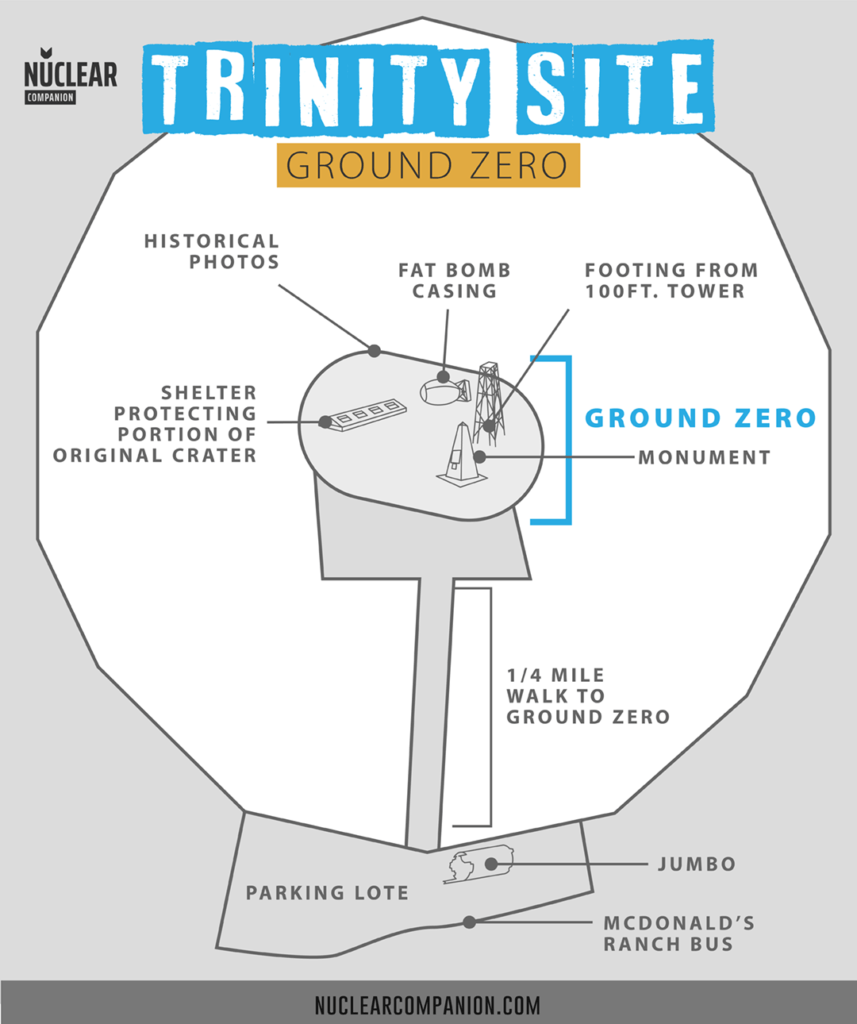
In the center of this GZ, there is a depression. This was the explosion crater, and It also has its chain-link fence. There is a barbed-wire fence connecting both the outer fence and inner fence.

What can you do at Ground Zero?
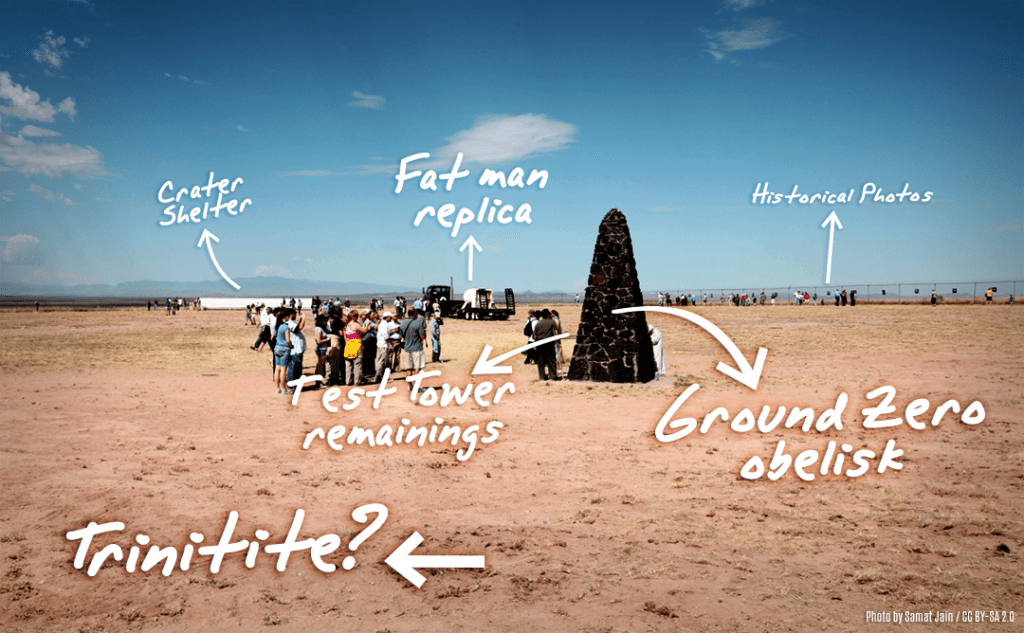
- Visit the ground zero commemorative obelisk
- Look for Trinitite
- Take some pictures of the Fat Man Bomb Casing in exposition
- Stand beside the remains of 100-Foot Tower that hold the bomb
- Take a look at the Shelter protecting a portion of the original crater
- Take a photo inside “Jumbo”
- Navigate the north fence along a series of historical pictures
Let’s get started!
1. Ground Zero Monument
Location: Trinity Site’s inner fence ( Google Maps )
The exact point of the blast occurred at ground zero. A 100-foot steel tower was constructed to release the bomb. The point at the bottom base of the tower is ground zero. Today, a stone obelisk marks the spot. It has a plaque that reads, “Trinity Site, Where the World’s First Nuclear Device Was Exploded on July 16, 1945.” It serves as a permanent reminder of the destructive force unleashed there.

2. Trinitite
The explosion blasted out a crater almost 1,200 feet across and up to 10 feet. It was so powerful that sand at ground zero was fused into a green glassy substance called “trinitite.”
In 1952, most of the Trinitite was removed and buried, while the crater was filled. Only small pieces of Trinitite remained at the site.
During the Open House, you will find a tent where a White Sands Missile Range installation safety officer talks to visitors about radiation and trinitite. Also, there you will be able to see Trinitite samples in a box and radiation detectors that visitors can use.
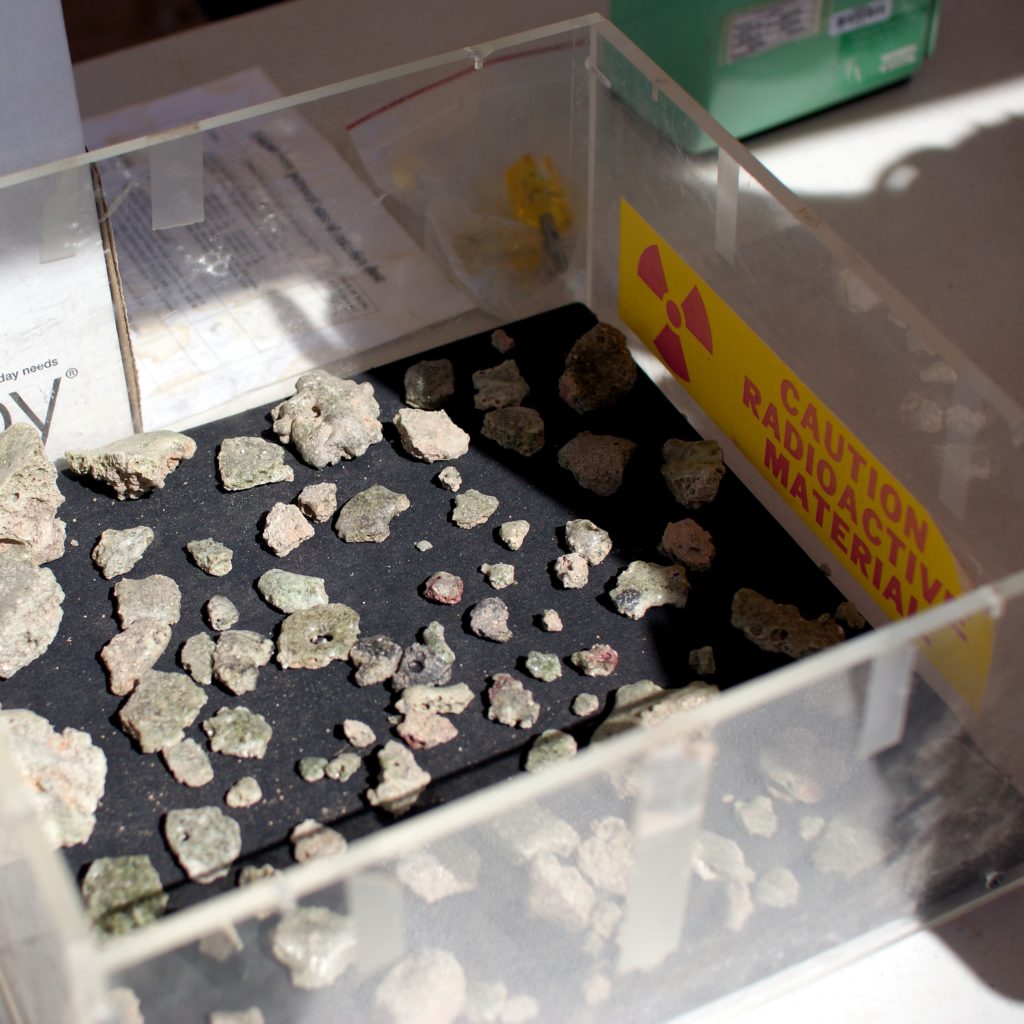
If you are lucky, perhaps you will find some trinitite on the site ground.
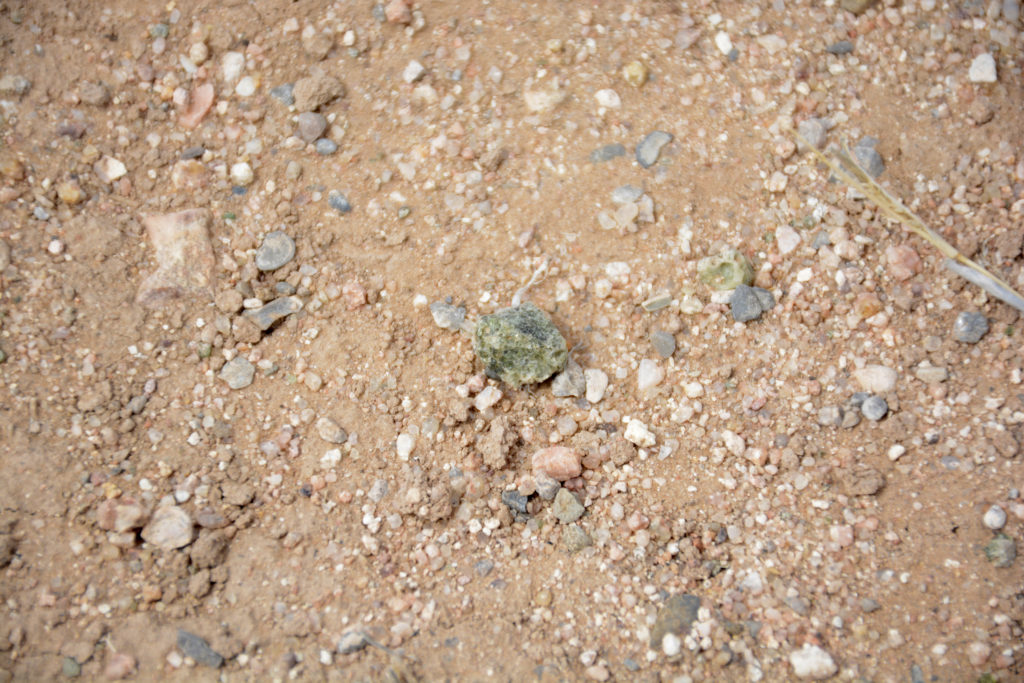
But be careful, the green glassy trinitite is still radioactive and must not be picked up. Also, its removal is illegal:
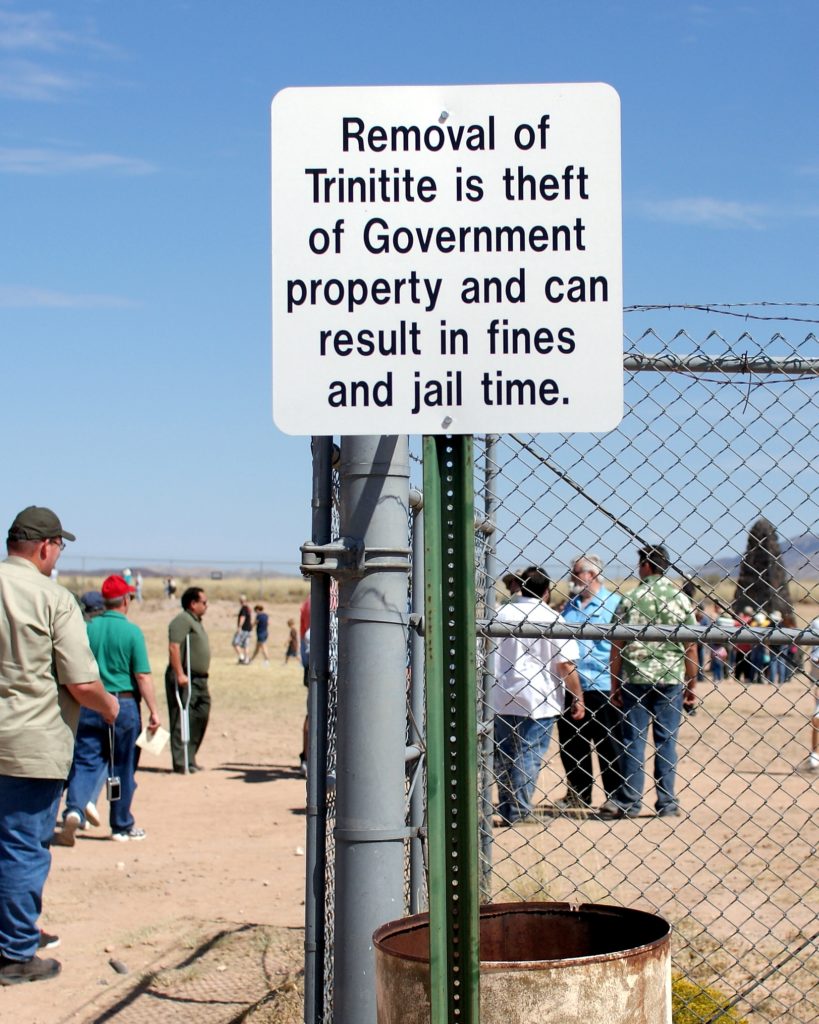
3. Fat Man Bomb Casing
Fat Man was the code name for the atomic bomb dropped on Nagasaki on August 9, 1945. When you visit the Trinity site, you can view the “Fat Man Bomb Casing.” This artifact is a reconstruction of the casing that held the bomb that fell on Nagasaki. During this part of the tour, you will understand how it got its name!
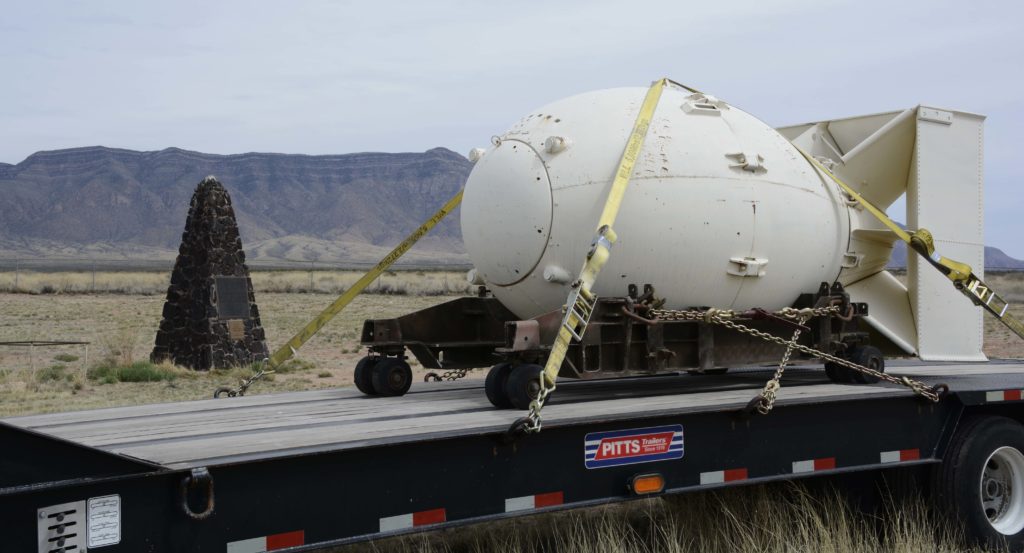
4. Remains of 100-Foot Tower
Location: Trinity Site’s inner fence
The steel tower for the test bomb became destroyed during the explosion. However, you can see the base of it at ground zero.
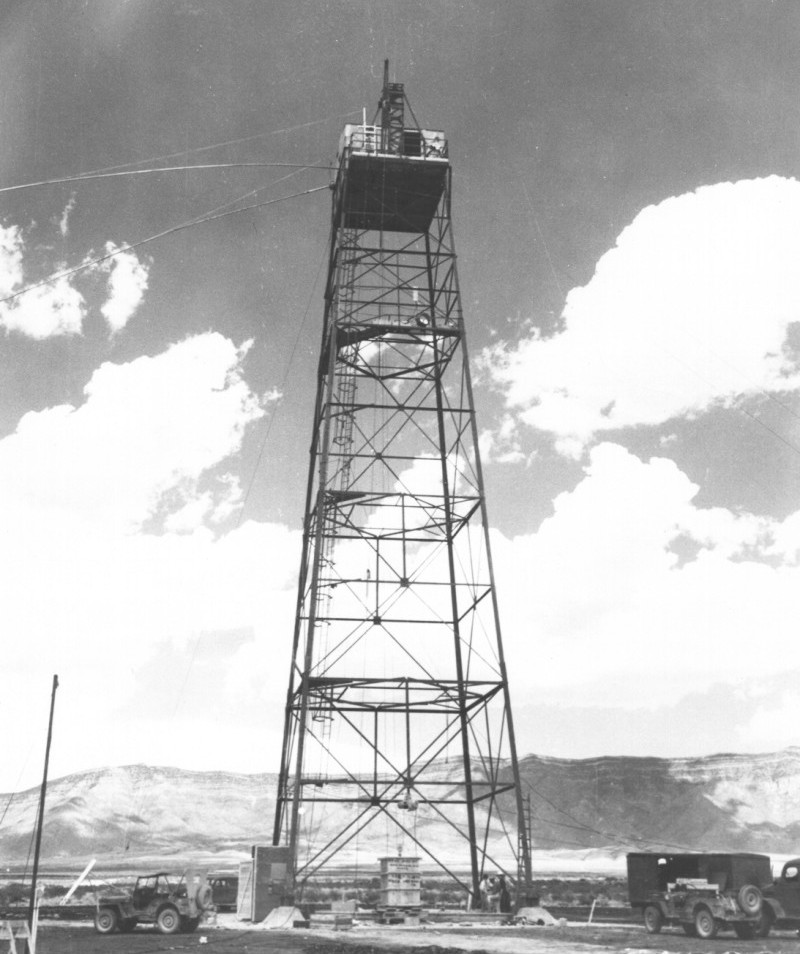
You will probably be quite surprised at how little there is to tell the story of what happened; however, keep in mind the blast ruined many of the structures.

5. Shelter Protecting a Portion of the Original Crater
The 1945 detonation created a huge crater and a new substance – Trinitite – from the radioactive glass that formed. Today, the Trinitite has been cleared out, along with the radioactive sand, and the crater mostly filled in. Remember that this site is a military base and missile range, not a museum.

This shed protects an undisturbed portion of the original crater. But, if you would like to take pictures here, you will be disappointed. The shelter’s hatches used to be opened so visitors could see undisturbed Trinitite but sand from windstorms covered it.
6. Remnants of Jumbo
Location: Trinity Site’s parking lot ( Google Maps )
Just in case the test proved to be a failure, they constructed a steel canister nicknamed “Jumbo.” It was created to hold the 13-pound plutonium device to protect against its radioactivity. Jumbo earned its name; it was 10 feet in diameter, 25 feet long, and weighed in at 214 tons! A 64-wheel trailer had to be used to haul it to the test site.

Fortunately, someone thought better of using Jumbo. The test was successful! Besides, had the plutonium been inside a steel case, molten radioactive material would have rained down all across the area. Today, you can see the remnants of Jumbo when you visit the Trinity test site.
Ironicaly, Jumbo is the most memorable permanent object at Trinity Site.

7. Historical photos display
In the north side of the inner fence, you will find a series of professionals photographs hanging from the fence. These are black and white pictures the site days before the explosion, the day itself, the explosion in slow motion and afterward.
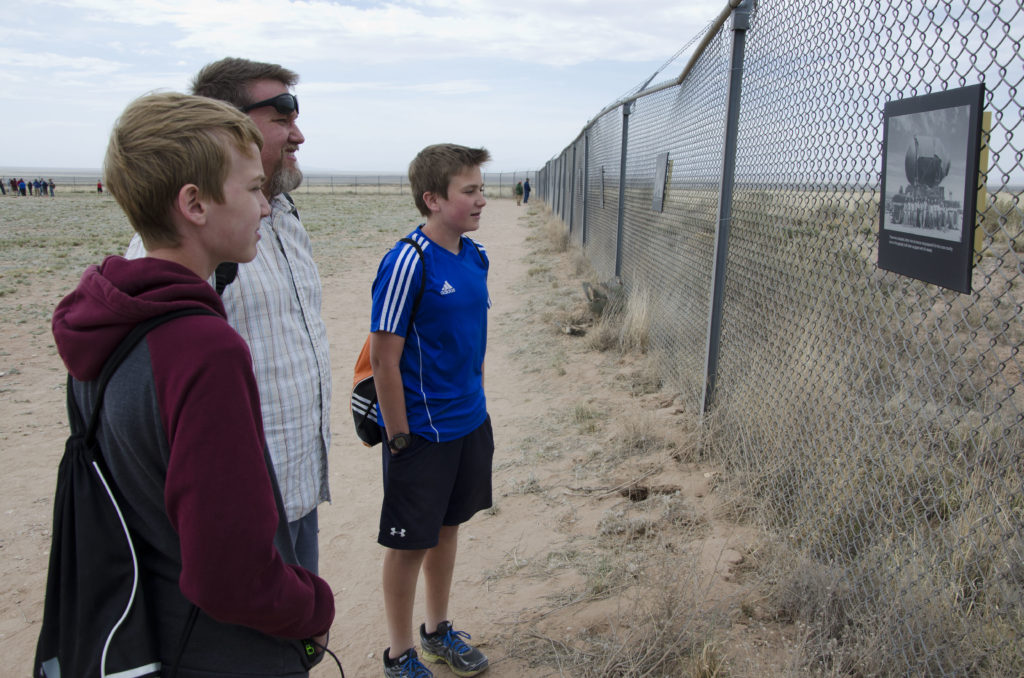
Besides Ground Zero, there are other exciting locations to visit.
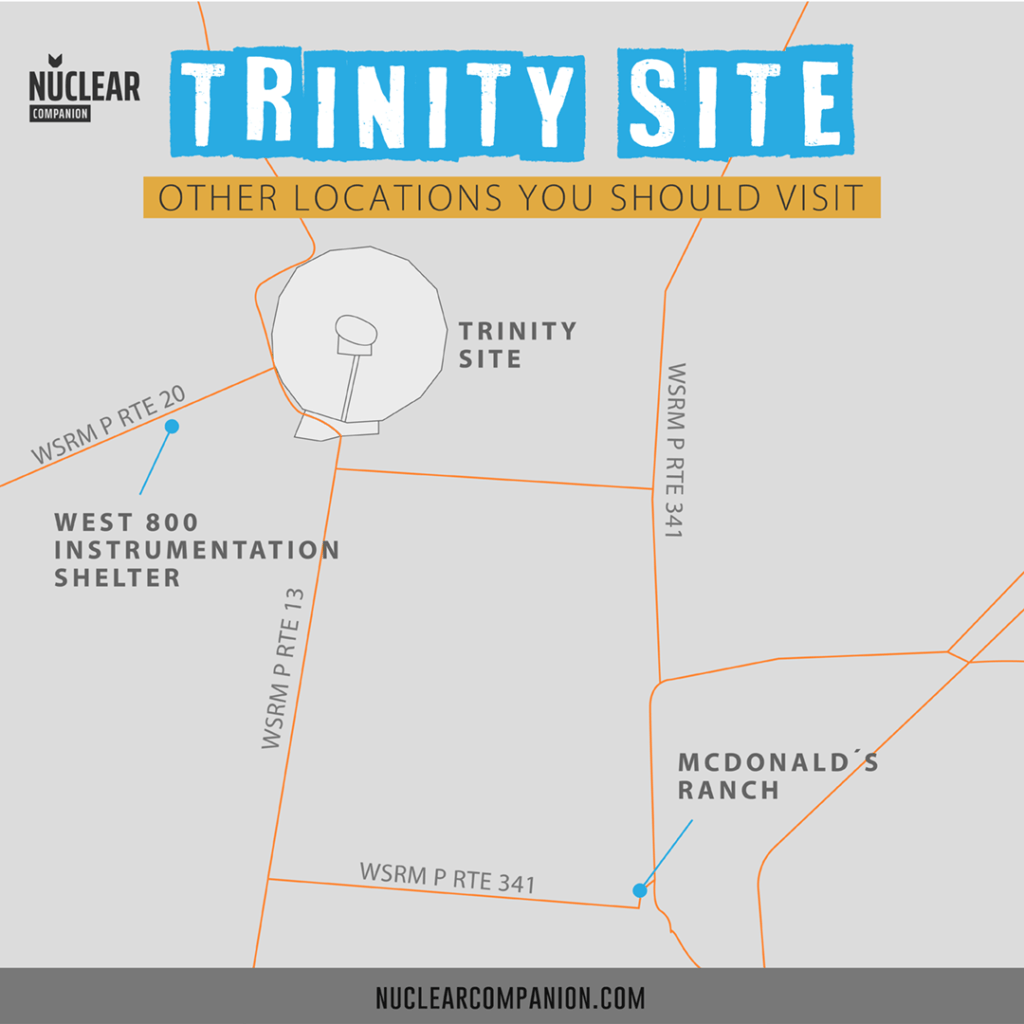
Specifically:
- West 800 Instrumentation Shelter
- The Schmidt/McDonald Ranch
Let’s dive right in.
1. West 800 Instrumentation Shelter
Location: 800 yards from ground zero by WSMR P Route 20 ( Google Maps )
The West 800 shelter was an instrumentation bunker. During the test, it contained equipment for measuring implosion characteristics. Up to the date, it is the only bunker that visitors can see.

Originally, there were seven bunkers. One control bunker, two manned observation bunkers and four instrumentation bunkers.
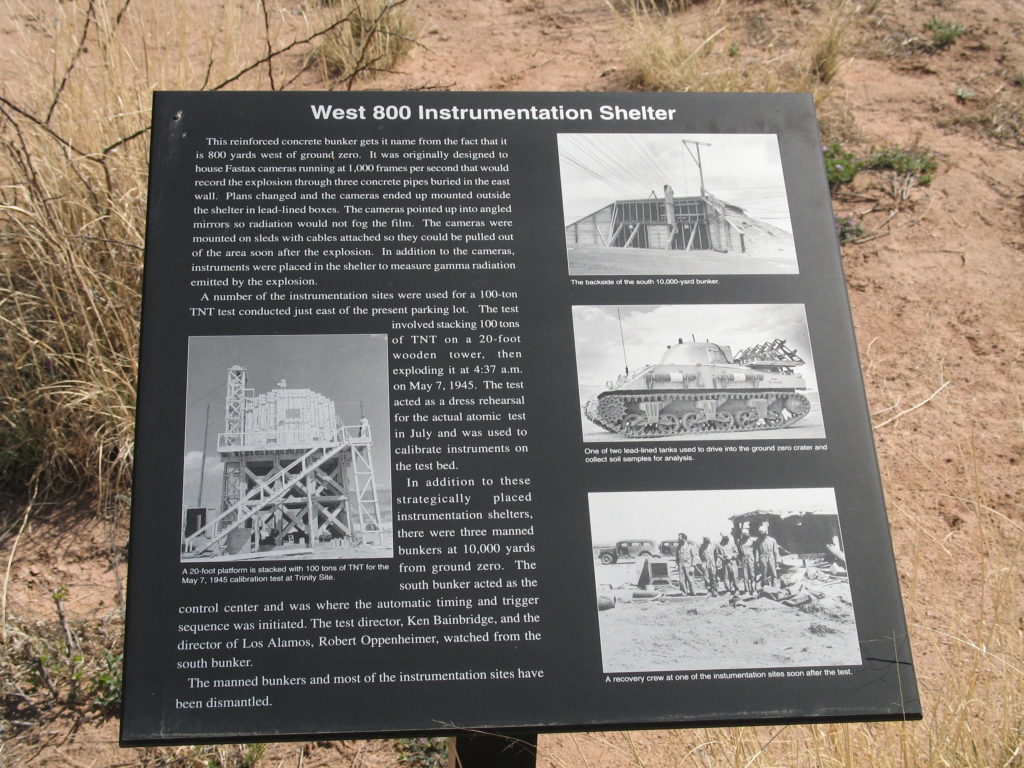
2. The Schmidt/McDonald Ranch
Location: 2 miles from ground zero ( Google Map )
The McDonald House was where the plutonium core of the bomb was assembled on July 13, 1945, shortly before being tested. A private family previously occupied the house, which dates back to 1913. However, the US government appropriated it for military use in 1942. The family protested against the acquisition but lost. They believed the government would return the land to them after the end of the war, but it remained in military control. Today, there is a family history on the family that lived there as part of the exhibit.
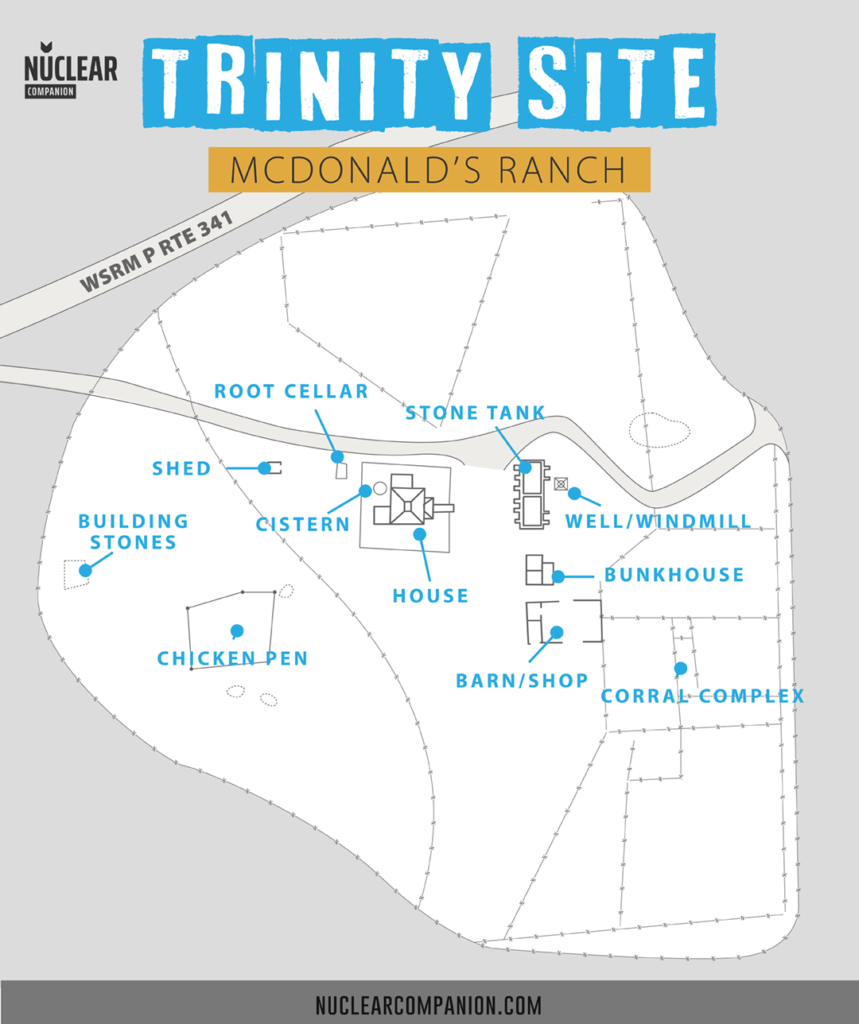
The McDonald House fell into disrepair after decades of neglect. In 1982, it was restored to look the way that it did on the day they constructed the bomb. Today, it is a must-see for anyone who is visiting the Trinity site. It is only open on the first Saturday of April and the first Saturday of October.
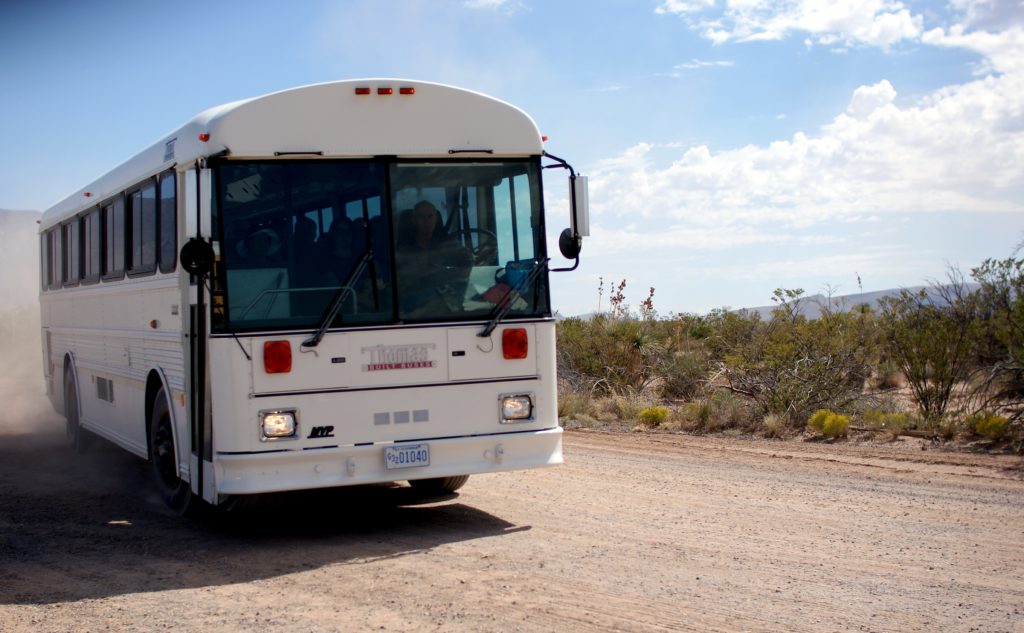
Touring the Ranch There is a bus that takes visitors from Trinity Site to the ranch house. It departs every half hour from the Trinity Site’s parking lot south end. The bus ride and visit to the McDonald Ranch take approximately 45 minutes round trip.
You can see many of the structures either from the initial explosion or recreations. Some places include the assembly station known as the McDonald House. Another is the base of the 100-foot steel tower, where they dropped the bomb. A stone obelisk marking ground zero is also available for viewing.
The site is only open to the public two days per year, the first Saturday of April and October, from 8 am until 2 pm.
Admission is free. Keep in mind that there is no food or water available, so come prepared.
No. The site is an active missile range and military range, so it is strictly off-limits to the public on days that it is not open.
The only time that you can visit the site is on its open house days, the first Saturday of April and October.
You probably won’t find any accommodation around White Sands (with the possible exception of some Air BnB homes). Plan to stay in a nearby city, such as Alamogordo or even Albuquerque. However, keep in mind these locations are about two to three hours away, depending on traffic.
Trinity site is on the White Sands Missile Range, a highly secure military base. Make sure that you bring photo ID for everyone in your group, or you may not be allowed access. Bring plenty of food and water. You will be walking around a lot, and in the desert heat, you may not realize that you have become dehydrated. Make sure that you bring enough water to sip on throughout your entire visit.
The Manhattan Project
During World War II, some countries from the Allied powers took part in what was known as the Manhattan Project. It was designed to develop nuclear weapons to help the Allies win the war. The Manhattan Project began in 1939. This assignment was so secretive that many of the 130,000 people who worked on it had no idea what they were actually working on.
The work began following a letter that Albert Einstein wrote to President Franklin D Roosevelt in 1939. Einstein was a German-born Jew who was visiting the US in 1933, the year that Adolf Hitler came to power; he chose to stay in the US rather than return to Europe. With the Nazi’s military expansion and the beginning of World War II, he received a tip that Nazi scientists were attempting to use the process of nuclear fission.
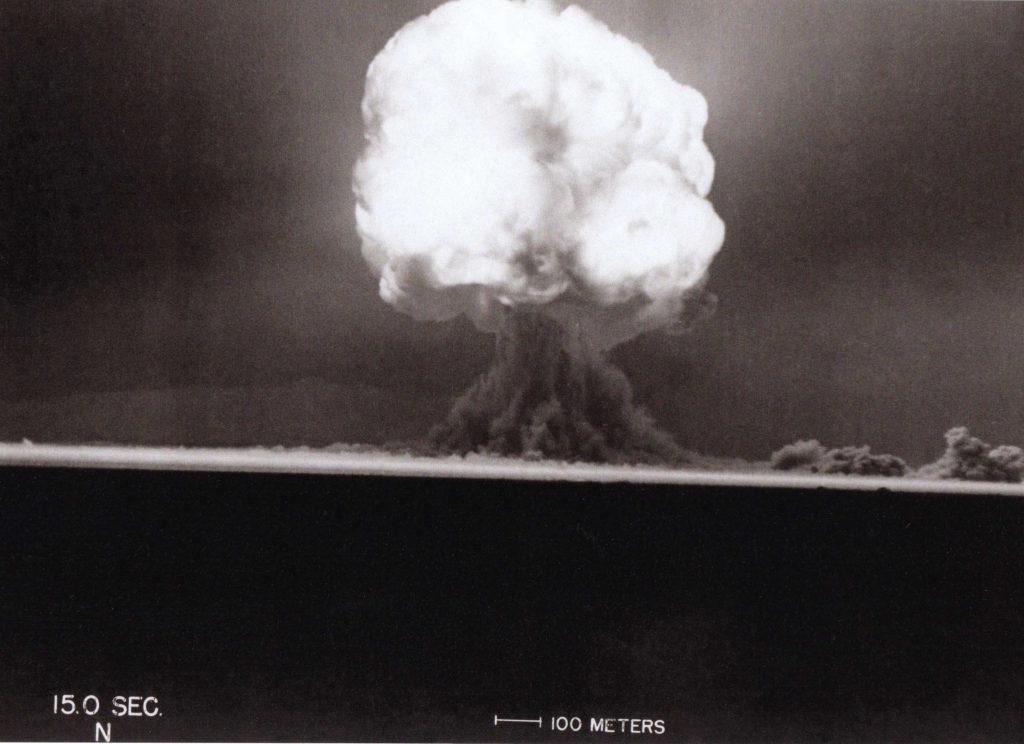
This notion meant they would release enormous amounts of energy, or basically a bomb. His letter to the president warned him of the impending danger should the Nazis succeed in developing such a weapon. Thus, Einstein urged him to beat the Nazis by building one first.
Ironically, because of Einstein’s political activism and German roots, he was denied the security clearance necessary to work on the Manhattan Project. In fact, scientists working on it were not allowed to consult with him in any way because Einstein was a threat to national security. Instead, the scientist who led the team was the nuclear physicist Robert Oppenheimer. He who famously declared at the bomb’s test site, “I have become death, the destroyer of worlds.”
Based on the letter that Einstein sent to Roosevelt, the United States began stockpiling uranium. It was with the understanding that uranium could potentially fuel a bomb many times more deadly than those previously known.
In 1941, the president created the Office of Scientific Research and Development, the OSRD, to oversee the creation of the bomb. He also formed an Advisory Committee on Uranium, which became the National Defense Research Committee on Uranium. The leaders of these organizations developed the S-1 Committee.
That first meeting of the S-1 Committee occurred on December 18, 1941, just 11 days after the attack on Pearl Harbor. The task could not be more urgent.
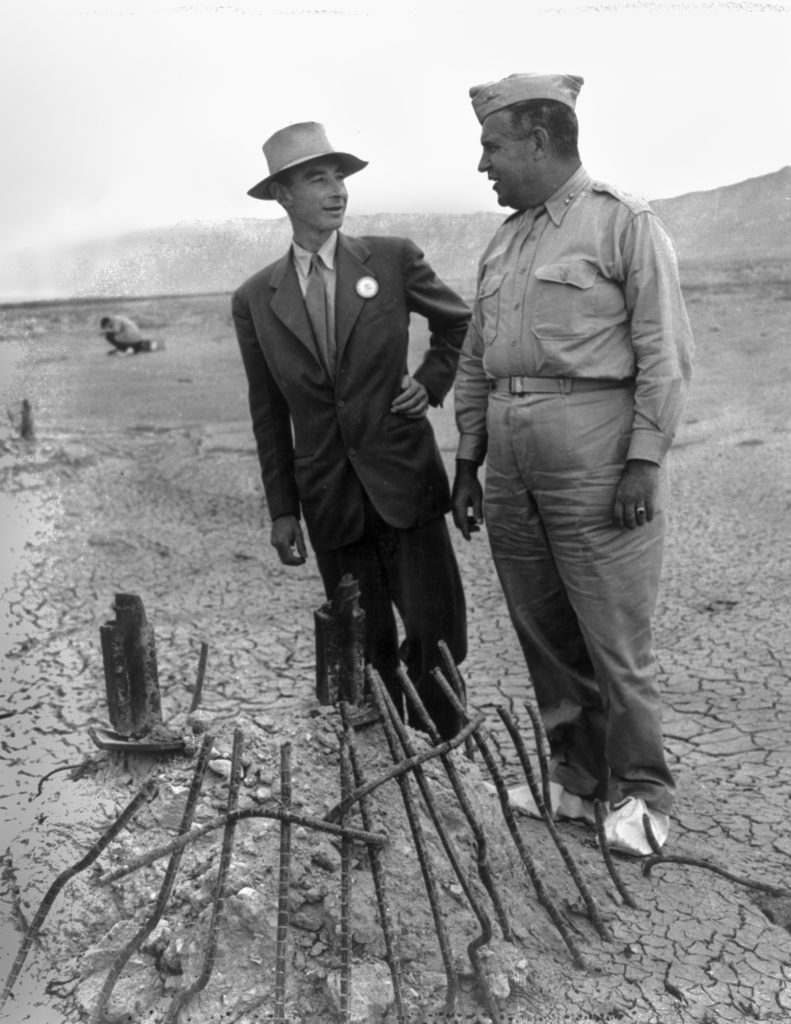
This team of scientists succeeded in creating a prototype bomb. However, it was from enriched plutonium rather than the uranium that the government had previously stockpiled, at the Los Alamos laboratory in New Mexico in 1945. The remote location of the laboratory enabled the team of scientists to work there in absolute secrecy. Likewise, the obscure, barren desert provided a perfect testing ground for the weapon.
Scientists would only get one chance to test out the bomb, so they had to do it right the first time. When it was carried out on July 16, the team knew that detonating the weapon had the potential to set the atmosphere on fire and obliterate all life on earth. The chain reaction triggered by the enriched plutonium led to the mushroom cloud appearing over the empty desert; it was then that the scientists knew that they had created the deadliest weapon in the history of the world.
When Albert Einstein learned that the bomb he had urged the president to build destroyed the Japanese cities of Hiroshima and Nagasaki, his response was, “Woe is me.” Though it helped end the war, hundreds of thousands of civilians died. Moreover, the world entered an era in which all life could end with the push of a button.
Today, the Trinity Test Site is a national historic landmark and is in the National Register of Historic Places.
Trinity Site on the U.S. National Park Service site
Have you ever visited the Trinity Test Site? or, are you planning a visit?
Or maybe you have a question.
Let me know by leaving a quick comment below right now.
Share this article
How far was the photo shelter from the blast on July 16, 1945?
I AM GOING TO BE 78 YEARS OLD NEXT MONTH. IF IT HADN’T BEEN FOR THE SUCCESS OF THE TRINITY TEST AND THE SUBSEQUENT USE OF THE LITTLE BOY AND THE FAT MAN AGAINST IMPERIAL JAPAN, I MIGHT NEVER HAVE KNOW MY FATHER OR ANY OF MY UNCLES!!!!! AND THE WAR IN THE PACIFIC COULD HAVE DRAGGED ON FOR DECADES, WITH MANY MORE MILITARY AND CIVILIAN CASUALTIES ON BOTH SIDES!!!!
I’ve never been there even though I’ve traveled Hwy 380 a few times. I would like to go this October 1, 2022. I travel with a well-behaved medium dog. Do you know if she can take the tour along with me? Is this tour a guided and timed tour, or is it a self-paced, self-guided tour?
Thank you for the very helpful information and advice in the article above!
Hi Scott, Thanks for writing. Pets are allowed as long as they are leashed and their waste is picked up and put into a trash receptacle. Pets are not allowed on the shuttle that takes visitors to the ranch house. Ground Zero in self-guided tour but theres is a 1/2 hour tour for the McDonald House.
Is a 4 year old child allowed with parent on the site?
Hi Gilbert, yes! All ages are welcome.
You wrote: “When it was carried out on May 7, …” Obviously, the correct date is July 16, 1945.
Hi!. Thank you for pointing out this mistake. We indeed made an error with the date. The correct date for the Trinity nuclear test is July 16, 1945, not May 7. We appreciate your attention to detail and will make the necessary correction immediately. Thanks again!
LEAVE A REPLY Cancel reply
Save my name, email, and website in this browser for the next time I comment.
- Term of use
- Privacy Policy
Get In Touch
© Copyright 2024 Nuclearcompanion.com. All rights reserved.
Trinity Site Offers a Rare Chance to Visit Ground Zero of the World’s First Atomic Bomb Explosion
The detonation site is only open to civilians twice a year
Jennifer Nalewicki
Travel Correspondent
:focal(994x575:995x576)/https://tf-cmsv2-smithsonianmag-media.s3.amazonaws.com/filer/34/79/34795f66-d57c-43f5-9756-92cca19620b5/32484456194_ab310c6193_k.jpg)
July 16, 1945 was a day that changed the world forever. At 5:29 a.m. Mountain War Time, just minutes before sunrise, the night sky above central New Mexico was illuminated in a brilliant fireball of white light as the U.S. military tested the world’s first atomic bomb . Called Trinity Site and located on the grounds of the White Sands Missile Range about 70 miles west of Alamogordo, the site is typically off limits to civilians—but on October 7, visitors can experience it firsthand during its biannual open house.
Held on the first Saturday of every April and October, the open house is the only opportunity the public has to access the missile range, which normally serves as an active site for the U.S. Army to test out new weaponry. During the open house, visitors can see ground zero, where the plutonium-based A-bomb was detonated more than 70 years ago as part of the Manhattan Project . The open house also includes a visit to the McDonald Ranch House, a 1913 adobe home built by Frank Schmidt, a German immigrant, and where the device’s plutonium core was assembled.
Today, a monolith marks ground zero along with what’s left of the footing of a 100-foot tower that military personnel used during the detonation. Also on view: photos taken during the explosion, and the leftover bomb casing from “ Fat Man .”
/https://tf-cmsv2-smithsonianmag-media.s3.amazonaws.com/filer/34/79/34795f66-d57c-43f5-9756-92cca19620b5/32484456194_ab310c6193_k.jpg)
“Most of the tower was vaporized during the explosion,” Drew Hamilton, a public information and community relations specialist for White Sands Missile Range, tells Smithsonian.com. “Since the explosion, much of the surrounding area has more or less returned to the way it would naturally be. There are no bushes growing around ground zero, but it’s because we regularly mow it. If we didn’t, it would look like the rest of the landscape.”
Visitors may also come across crumb-size pieces of Trinitite, a rock-like byproduct leftover from the explosion known for its glassy texture and deep green hue. (Since White Sands is a national monument, however, visitors are prohibited from removing anything from the site.)
/https://tf-cmsv2-smithsonianmag-media.s3.amazonaws.com/filer/09/62/0962d3e3-c269-4f55-8093-f7ea42fbab9b/33474864050_c5565beeda_k.jpg)
And while Trinity Site has been cleaned up since the atom bomb detonation, its radiation levels remain above that of naturally occurring background levels. To put this into perspective, Hamilton gives the following example:
“Radiation is everywhere, it’s a naturally occurring phenomenon,” he says. “But it’s a little bit higher [at Trinity Site as compared to] the surrounding territory. During a one-hour visit, you’ll be exposed to approximately half a millirem of radiation. In comparison, during a flight aboard a commercial airliner from New York City to Los Angeles, you’ll be exposed to 2 millirems. You’ll get the same exposure from the Trinity Site as you would if you ate eight bananas, which, because of their potassium content, are naturally radioactive.”
This year’s Trinity Site open house will take place from 8 a.m. to 2 p.m. on October 7. Admission is free and reservations are not required. Pets are allowed and must be leashed. To reach Trinity Site, take exit 139 off Interstate 25 to State Highway 380 and drive east 12 miles to Stallion Gate. Make sure to bring a valid ID to show at security checkpoints. Drivers should be prepared to provide proof of insurance.
Get the latest Travel & Culture stories in your inbox.
Jennifer Nalewicki | | READ MORE
Jennifer Nalewicki is a Brooklyn-based journalist. Her articles have been published in The New York Times , Scientific American , Popular Mechanics , United Hemispheres and more. You can find more of her work at her website .
Trinity Site: What you need to know before you go

WHITE SANDS MISSILE RANGE — At precisely 5:29:45 a.m. on July 16, 1945, a tremendous explosion in the New Mexico desert signaled the beginning of the end of World War II.
The explosion was the world's first atomic bomb and as part of the Manhattan Project, it had been tested at the Trinity Site, now known as the north end of White Sands Missile Range.
Today Trinity Site is open to the public at 8 a.m. but closes promptly at 3:30 p.m.
According to White Sands Missile Range, the atomic bomb released 19 kilotons of power, instantly vaporizing the tower it was on and turning the surrounding asphalt and sand into green glass. The shock of the bomb broke windows 120 miles away and was felt by many as far away as 160 miles.
Success of the test meant an atomic bomb using plutonium could be used by the United States military in Japan during World War II.
Tour the Trinity Site
Touring the Trinity Site is free but it's only opened to the public twice a year, on the first Saturday in April and October. Thousands of visitors enter the site from either the Stallion Range Gate or the Tularosa Gate.
Entering the site from the Tularosa Gate entails joining your vehicle in a caravan at Tularosa High School football field parking lot, 1305 Eight St., in Tularosa. This caravan enters the site at 8 a.m. and is led by military police. From the Tularosa Gate, it's a 75-mile drive to the site and there are no gas stations on the route or at the site.
Everyone 18 and older must show a valid driver's license , pass port or DoD issued identification. All vehicles are subject to search and should be carrying proof of insurance and current registration papers. No weapons of any kind are allowed on the installation.
Entering the site from the Stallion Range Gate is a 17-mile trip and visitors are allowed to drive in and out of the site unescorted from 8 a.m. to 2 p.m. The Stallion Range Gate is located five miles south of U.S. Highway 380 and the turnoff is 12 miles east of San Antonio and 53 miles west of Carrizozo.
Both roads are paved and marked. The site closes promptly at 3:30 p.m.
At the site, visitors can take a quarter-mile walk to ground zero where a small obelisk marks the exact spot where the bomb was exploded. Historical photos are mounted on the fence surrounding the area. Visitors also can ride a missile range shuttle bus two miles to the Schmidt/McDonald ranch house. The ranch house is where the scientists assembled the plutonium core of the bomb.
Tularosa Basin Downwinders
The Tularosa Basin Downwinders believe the Trinity test disturbed the genetics of residents in surrounding communities, leaving a cluster of cancer and illness in the those who witnessed the atomic bomb, and their descendants. For 13 years, the Downwinders have collected data, met with New Mexico's U.S. senators and continued fighting for inclusion in the Radiation Exposure Compensation Act (RECA).
Semiannually when the Trinity Site opens to the public, the Downwinders host peaceful demonstrations at the Stallion Range and Tularosa Gates, informing visitors about their cause.
More: Downwinders aim to educate public about Trinity Site test
The Downwinders have been invited twice to testify in front of Congress during hearings for RECA amendments but both times the hearings have been postponed. The Downwinders were recently given word that the hearings might be rescheduled for this summer and are preparing to travel to Washington, D.C.
Last month, the Downwinders hosted a town hall in Carrizozo and listened to residents who were just 33 miles from the Trinity Site when the atomic bomb was tested.
Read More: Tularosa Basin Downwinders to host Carrizozo town hall
Read More: Tularosa Downwinders make strides in battle for recognition
For more information about the Tularosa Basin Downwinders, visit their website at www.trinitydownwinders.com .
For more information about Trinity Site go online at wsmr.army.mil/Trinity/Pages/Home.aspx
- Share full article
Advertisement
Supported by
Touring Trinity, the Birthplace of Nuclear Dread
A recent visit to the site of the first atomic bomb explosion offered desert vistas, (mildly) radioactive pebbles and troubling reflections.

By Dennis Overbye
Listen To This Article
TRINITY SITE, N.M. — Once, in another lifetime, I witnessed an atomic explosion. This was in the 1960s at the Nevada Test Site, a vast area about an hour northwest of Las Vegas where the American military tested bombs. I was working for EG&G, a military contracting company that, among other atomic chores, supplied all the instrumentation for the test site; it is now part of a company called Amentum. My job, to study the effects of nuclear explosions on the atmosphere, was sufficient to keep me out of the Vietnam War draft.
Cabriolet, as the test was called, contained the force of 2,300 tons of TNT. Detonated hundreds of feet underground, it was louder than I thought anything could ever be. The ground bulged, and a line of torches marking ground zero flew into the air. From a shaking trailer four miles away, my boss and I filmed tongues of fire erupting from the earth and congealing into an elephant-shaped cloud of dust that drifted off in the general direction of Montana.
Those were heady days in the atomic business, when people thought they could build harbors in a few microseconds of fury, or dig a new Panama Canal overnight in a domino of blasts, or even propel spaceships. Cabriolet was part of the Plowshare Program, which looked for peaceful civilian uses of nuclear explosions. Turns out all they are good for is terror.
Where it all began
Twice a year, on the first Saturdays of April and October, the U.S. Army opens the gate to the White Sands Missile Range in New Mexico, allowing in civilians to tour a patch of sand known as the Trinity Site, where the very first atomic explosion was set off and the history of nuclear dread began. It was so named by J. Robert Oppenheimer, the physicist who led the Manhattan Project to build the bomb, inspired by lines like these in the poems of John Donne .
Batter my heart, three-person’d God, for you As yet but knock, breathe, shine, and seek to mend; That I may rise and stand, o’erthrow me, and bend Your force to break, blow, burn, and make me new.
According to the Trinity website , the Stallion Gate would open promptly at 8 a.m.; when we arrived not long after the crack of dawn, a four-mile-long caravan of cars was ahead of us. The idea to visit came from Michael Turner, an old friend and cosmologist recently retired from the University of Chicago and now with the Kavli Foundation in Los Angeles.
Dr. Turner had grown up under the Promethean promise of that mushroom cloud and 20th-century science. Everybody who was anybody in physics had worked on the Manhattan Project. As a young physicist in the 1960s and ’70s, Dr. Turner was part of a young band of physicists who invaded astronomy and turned cosmology into particle physics or perhaps vice versa. He had never visited the Trinity Site — he hadn’t known you could go there until recently, he said. And being open only two days a year presented a logistical challenge.
He brought along an old pal from his undergraduate days at the California Institute of Technology, Robert J. Miller, who had helped invent the computer touch pad. Because visiting day coincided with the annual Albuquerque International Balloon Fiesta the hotels were full, and the three of us had to share a single room. I don’t remember who paid for the room; I paid for the rental car. Nobody snored.
Once inside the gate, we drove for a half-hour, past desert hills dotted with radar and telescope domes, to a dusty parking lot manned by fresh-faced young men in Army camo fatigues. A line of port-a-potties occupied one corner of the lot, arrayed as if for an outdoor rock concert.
The first thing on display was the Jumbo , a steel barrel 12 feet or so wide with walls as much as 16 inches thick; it rested on its side like a culvert, allowing visitors to walk through. The original plan was to detonate the Gadget — the Manhattan Project physicists’ term for the bomb — inside the Jumbo. If the bomb fizzled, the Jumbo would corral the $250 million worth of plutonium that was the explosive core of the device.
We continued through a gate and down a path lined with barbed wire, Keep Out signs and warnings about rattlesnakes, to a fenced-in area littered with glassy gravel, sand and tufts of sagebrush and sparse grass. It was here at 5:29:45 a.m. on July 16, 1945, that arguably the most consequential physics experiment of the 20th century took place.
The bomb would use explosives to squeeze a softball-size lump of plutonium to critical density, ideally resulting in a soul-rattling explosion. It worked, lighting up the New Mexico landscape a few minutes before dawn and causing Dr. Oppenheimer to mutter to himself a verse from the Bhagavad Gita: “Now I am become death, destroyer of worlds.”
Three weeks later, on Aug. 6, 1945, a bomb of slightly different design was dropped on Hiroshima, killing an estimated 140,000 people. It shot two hunks of uranium together, creating the critical mass needed for a chain reaction to occur; scientists were so certain the design would work that they did not even bother testing it before it was deployed. Fat Man, a plutonium bomb of the kind tested at Trinity, was used on Nagasaki on Aug. 9, and the end of World War II soon followed.
Trinkets of the Apocalypse
At Trinity’s ground zero, hundreds of people were milling around as if at a county fair, but there was little to see. The detonation created a crater eight feet deep, a half-mile wide and lined with glassy pebbles called trinitite: sand that had been swept up in the fireball, vaporized and then fell back down in molten radioactive droplets. But gradually the pebbles were shoveled out and the hole filled with scrubby sand, weeds and rocks. Now display stands sold snacks and souvenirs; at one table, docents were using a Geiger counter to show off mildly radioactive rocks.
The Gadget was detonated atop a 100-foot tower. All that remained was an inch-long stub of metal sticking out of the ground. An obelisk of black rocks, with a plaque commemorating the event, marked the exact point of ground zero; we took turns posing in front of it and a life-size model of Fat Man, which resembled a short, bulbous submarine with enormous tail fins.
The ground below our feet was littered with green shards of trinitite. They were allegedly radioactive, and signs warned that removing any stones constituted theft of government property and could lead to fines or even jail time.
The signs seemed to remind visitors to bend down and retie their shoelaces, perhaps to gather a promising souvenir or two of the original sin in the process. Some days later, in an email, Dr. Turner wrote that his piece of trinitite “has a proud place in my rare gem collection, kept two meters away from me (for radioactive safety. :-).”
Any such caution was unnecessary for me. On returning home, I took my bounty of trinitite to the office and gave it to a colleague whose spouse taught chemistry and had access to a Geiger counter. I was hoping that my pebbles would be at least as radioactive as a banana, but my friend’s verdict came the next day. “Pathetic,” he said.
Two miles away, amid the scrubby brush and sand and accessible by a bus ride, was a property known as the McDonald Ranch. It was in the main bedroom of the ranch house that the youngsters who would become the physics elders of Dr. Turner’s generation gingerly finished assembling the Gadget, inserting the plutonium core.
In their down time they went swimming in a cistern that had held water for the horses and other animals. Rising above the sagebrush was a wooden observation tower looking lonely and ancient against the blue sky, keeping a rustic vigil on the past.
An emerging history of near-misses
There are now more than 13,000 nuclear warheads on Earth , according to a recent compilation by the Federation of American Scientists. Perhaps miraculously, not one has been detonated in anger since 1945, although stories keep emerging of close calls.
Recently it was revealed that when the Chinese Communists seemed to be threatening Taiwan in 1958, the American military drew up plans to bomb mainland China. Another near-tragedy occurred on Sept. 26, 1983, three weeks after Soviet fighters had shot down Korean Air Lines Flight 007.
Stanislav Petrov, a lieutenant colonel in the Soviet Air Defense Forces , was in charge that day of a command center called Oko (“eye,” in Russian), an early-warning system that relied on a network of satellites to detect attacks. The system reported that a half-dozen missiles had been launched from the United States and were headed toward the Soviet Union.
Colonel Petrov’s task was to relay the warning to his superiors in Moscow, who were likely to order a retaliatory strike. But Colonel Petrov, an engineer by training, held back, worried that the signal might be a false alarm. Several tense minutes in the early-warning command center passed by until finally ground-based radar confirmed that no missiles were incoming. The error was later traced to unusual reflections from high-altitude clouds.
Colonel Petrov was later reprimanded for insufficiently documenting his work on that day. To the rest of the world he was a hero. In 2006 he was invited to address the United Nations and tour the United States, a trip that was documented in a film, “ The Man Who Saved the World .”
In the course of his United Nations visit, he visited a Minuteman missile silo and its deactivated missile.
“Wow,” the former Soviet colonel says in the film. “You’re beautiful.”
Then his guide, a friendly young man, begins to explain that, according to policy, the weapon would have been launched only in response to a Soviet attack. Colonel Petrov erupts. “Brainless goat,” he says. “We were doing the same thing. We weren’t creating weapons to attack you, we were creating them for defense.”
Asked if atomic bombs would ever be used in war again, Colonel Petrov pauses. “I think so,” he says. “It’s absurd.”

Sync your calendar with the solar system
Never miss an eclipse, a meteor shower, a rocket launch or any other astronomical and space event that's out of this world.

Exploring the Solar System
A guide to the spacecraft beyond Earth’s orbit.
Dennis Overbye joined The Times in 1998, and has been a reporter since 2001. He has written two books: “Lonely Hearts of the Cosmos: The Story of the Scientific Search for the Secret of the Universe” and “Einstein in Love: A Scientific Romance.” More about Dennis Overbye
What’s Up in Space and Astronomy
Keep track of things going on in our solar system and all around the universe..
Never miss an eclipse, a meteor shower, a rocket launch or any other 2024 event that’s out of this world with our space and astronomy calendar .
Scientists may have discovered a major flaw in their understanding of dark energy, a mysterious cosmic force . That could be good news for the fate of the universe.
A new set of computer simulations, which take into account the effects of stars moving past our solar system, has effectively made it harder to predict Earth’s future and reconstruct its past.
Dante Lauretta, the planetary scientist who led the OSIRIS-REx mission to retrieve a handful of space dust , discusses his next final frontier.
A nova named T Coronae Borealis lit up the night about 80 years ago. Astronomers say it’s expected to put on another show in the coming months.
Is Pluto a planet? And what is a planet, anyway? Test your knowledge here .
Trinity Site
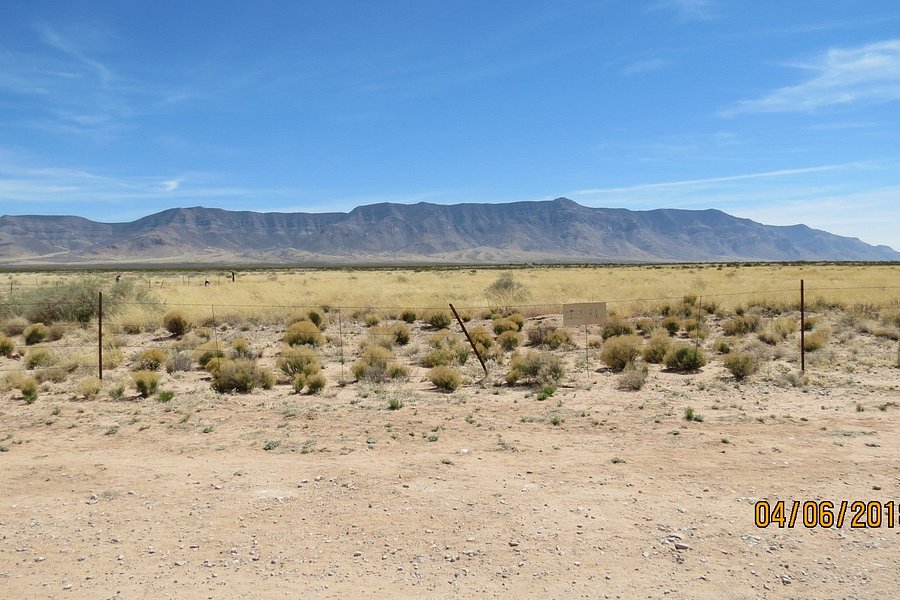
Top ways to experience nearby attractions

Most Recent: Reviews ordered by most recent publish date in descending order.
Detailed Reviews: Reviews ordered by recency and descriptiveness of user-identified themes such as wait time, length of visit, general tips, and location information.
Also popular with travelers

Trinity Site - All You Need to Know BEFORE You Go (2024)

White Sands Missile Range Museum
Atomic. Missile. Space. Birthplace of American Ages.
Trinity Site

Trinity Site Open House
The 51,500-acre area was declared a national historic landmark in 1975. The landmark includes Base Camp, where the scientists and support group lived; Ground Zero, where the bomb was placed for the explosion; and the Schmidt/McDonald Ranch House, where the plutonium core to the bomb was assembled. Visitors to a Trinity Site Open House are given the opportunity to visit Jumbo, Ground Zero, and the Ranch House. In addition, one of the old instrumentation bunkers is visible beside the road just west of Ground Zero.

This marker shows the location of Stallion Range Gate, the general public entrance to Trinity Site off of Highway 380.

National Museum of Nuclear Science & History
Trinity Site

J. Robert Oppenheimer gave the code name “Trinity” to a remote patch of the Jornada del Muerto Desert as a tribute to a line from a poem by John Donne. Soon after, teams of scientists and soldiers descended on the area, setting up a base camp and installing equipment in preparation for the world’s first nuclear test. After months of dueling with the limits of technology and the region’s harsh weather conditions, the scheduled test date arrived. On July 16, 1945, the “Gadget” nuclear device was detonated from a steel tower, exploding with a force that would forever alter human history.
The mushroom cloud rose almost eight miles high and left a crater that was ten feet deep and over 1,000 feet wide. Pieces of a green, glass-like and mildly radioactive mineral were scattered in and around the crater. Dubbed “Trinitite,” investigators theorized that desert sand was lifted by the blast, liquefied by the tremendous temperature and rained down on the earth.
Groves and Oppenheimer with his signature porkpie hat returned to the Trinity site about six weeks after the explosion on Sunday, September 9, 1945. The twisted metal rods were all that remained of the 100-foot tower. The press was invited for the first time in part to dispel fears of lingering high radiation levels.
For more on the Trinity test, click here. For rare photographs taken by Marvin Davis, an MP stationed at the Trinity site, click here . For videos of the Trinity test, visit our YouTube channel.
After the War
In 1952, the site of the first atomic explosion was bulldozed and most of the trinitite removed. The site received a National Historic Landmark designation in 1965 and was listed on the Register of Historic Places less than a year later.
Ground Zero at Trinity is marked by a 12-foot obelisk made of lava rock. Its inscription reads: “Trinity Site: Where the World’s First Nuclear Device Was Exploded on July 16, 1945.”
An 80-ton steel vessel, Jumbo , was built to contain the precious 13 pounds of plutonium in the event that the bomb failed to detonate. Jumbo illustrates Groves’ cautious approach to the project, always having a backup plan in case of failure.
Because Jumbo was never needed, General Groves was concerned that Congress would criticize him for spending $12 milllion on a white elephant. He ordered that the vessel be destroyed. However, eight 500-pound bombs succeeded only in blowing off its ends.
The Trinity site is open to the public on the first Saturdays in October and April. Eventually, the site may be affiliated with the Manhattan Project National Historical Park and open more often.
General Leslie R. Groves and J. Robert Oppenheimer after the successful Trinity test
Oppenheimer with the "Gadget" before the Trinity test
Norris Bradbury with the "Gadget" on top of the Trinity test tower
Moving Jumbo to Trinity site
General Groves, Oppenheimer and other scientists inspecting Ground Zero
William Laurence & General Groves
Trinitite. Photo courtesy of LANL.
Gadget at Trinity
The explosion at Trinity
The Trinity site after the explosion with the crater
Bringing the Gadget to the top of the Trinity site
AHF President Cindy Kelly with her husband Bill Kelly at the Trinity site monumentt
The partially destroyed Jumbo at Trinity site today
Trinity test shot .1 seconds
Trinity test shot .016 seconds
Trinity test shot .025 seconds
Trinity test shot .053 seconds
Jumbo on train
Moving Jumbo
Jumbo on specially constructed flat-car
Jumbo on freight car
Jumbo suspended in tower
Jumbo and collapsed tower after the Trinity test
McDonald Ranch headquarters
McDonald Ranch
Optics Group headquarters
Gadget test tower
Gadget being hoisted
Herb Lehr and Harry Daghlian transporting the plutonium core before the Trinity Test
Slug ready for Gadget
Assembly of the Gadget
Lead lined tanks at Pope, NM
Photographic shelter at Point P (10,000 W)
Camera at Campana Hill station
Site B (Timing Control Center)
1000 north after the test
Aerial of the Trinity site crater
Completed assembly of the TNT tower
First layer of high explosives on the TNT test tower
Stacking high explosives on the TNT test tower
Herb Lehr with the Active Material
View from the Top of the Tower
10,000 N Shelter
Green Glass - Trinitite - at 200 W after the Test
- Newsletters
Site search
- Israel-Hamas war
- Home Planet
- 2024 election
- Supreme Court
- TikTok’s fate
- All explainers
- Future Perfect
Filed under:
- Defense & Security
How should we remember Trinity Site, where the first nuclear bomb was tested?
Oppenheimer’s Trinity Site is where the end began.
Share this story
- Share this on Facebook
- Share this on Twitter
- Share this on Reddit
- Share All sharing options
Share All sharing options for: How should we remember Trinity Site, where the first nuclear bomb was tested?
/cdn.vox-cdn.com/uploads/chorus_image/image/72534128/trinity.0.jpg)
To reach the spot where the nuclear age was born and human history swung, turn off of Route 380 at Stallion Gate on the northern edge of the US Army’s White Sands Missile Range, not far from the tiny desert town of Socorro, New Mexico. Drive through the flat, dry, empty scrub the Spanish called Jornada del Muerto, or the Journey of Death, ringed at the horizon by the Sierra Oscura, the Dark Mountains.
After 17 miles or so you’ll reach a vast parking lot that stands largely empty much of the year. Walk past a mangled 200-ton steel tube called Jumbo, and stand before a stone obelisk mined from nearby volcanic rock. The words on the plaque will tell you where you are: Trinity Site — where the world’s first nuclear device was exploded on July 16, 1945 .
Trinity has largely faded from the public consciousness, overshadowed first by the horror of the atomic bombings of Hiroshima and Nagasaki, and later altogether as the fear of the bomb itself began to recede in the post-Cold War era. After World War II, the Interior Department tried to create a national monument at Trinity Site, but its efforts were continually frustrated by the military, which wanted to retain White Sands to test its growing inventory of missiles away from the public.
In truth, Americans have never known what to think about Trinity, simultaneously the greatest of technical and scientific achievements, the culmination of the Manhattan Project, and the birthplace of the first weapon of mass destruction, where the means to kill millions was tried and tested. It wasn’t until 1975 that Trinity Site was finally declared a National Historic Landmark — a few ranks down from a National Historical Park — and even now it remains largely closed to visitors, save for two Saturdays a year in April and October.
You can expect crowds to grow this fall, because the Trinity test is the hinge of Christopher Nolan’s hit biopic Oppenheimer , on the man behind the Manhattan Project. But what does it feel like to stand at the spot of Ground Zero, the site where, as Matt Damon’s General Leslie Groves says in the film: “the most important fucking thing to ever happen in the history of the world” actually happened?
The day the sun rose twice
I had a chance to visit Trinity Site myself in the spring of 2018, when I was researching my book End Times: A Brief Guide to the End of the World . I’m not sure what I expected as I broiled under the New Mexico sun. A moment of existential clarity? Some monument that represents the enormity of what happened here, the moment and the place where human beings demonstrated that they would now have the power to destroy themselves?
But save for a two-inch chunk of concrete left from the original tower, and the bits of glassy green called trinitite that were liquified in the blast before falling to the earth as hardened shards, there’s little indication at Trinity Site today of what occurred more than 70 years ago. And even the more immediate aftermath left some of the witnesses underwhelmed. A few weeks after the test, Gen. Groves, the director of the Manhattan Project and Oppenheimer’s boss, was driven out to the site on an observation trip. A Manhattan Project physicist remembered Groves looking at the crater left by the first atomic bomb and remarking : “Is that all?”
But no one who witnessed the day the sun rose twice ever forgot the experience, a fact ably captured in Nolan’s magisterial recreation of the event. The day of my visit to Trinity, frame-by-frame photos of the moments after the bomb’s detonation were arranged against the fence. Here’s how I described it in my book:
At 0.006 seconds there is a bubble of perfect light, as if the dawn itself had blossomed suddenly out of the desert ground. The heat of the blast is thousands of times hotter than the surface of the sun, and the light in that single moment was a dozen times brighter. At 0.025 seconds, the bubble head keeps rising, while a fringe of fire spreads across the ground… At 0.053 seconds, that perfect bubble begins to lose its clarity, becoming diffused and unfocused, as if overwhelmed by its own energy, while the inferno at the surface expands, gouging out the earth below. At this point every living thing within a radius of a mile is dead, or will be soon. At 0.10 seconds, the blast looks like nothing less than a halo on the head of some Renaissance painting of Christ, as the exposure itself begins to degrade. The atomic heat has made the air grow luminous, as the force of the shock wave expands outward, shredding the matter in its path. Everything is ravaged, everything is burned. And at 15 seconds after detonation comes the familiar image of the mushroom cloud, what the art historian John O’Brian called “the logo of logos of the 20th century” ... That mushroom cloud — like nothing seen on Earth before — is the result of intense heat at the heart of the blast, causing the air to rise in a column, before it spreads out in a mushroom’s cap.
In their definitive biography American Prometheus , the source material for Nolan’s film, Kai Bird and Martin J. Sherwin wrote that no one can know what flashed through the physicist’s mind as he beheld the thing that he, more than any other person, had willed into being. Oppenheimer’s brother Frank remembered that, “I think we just said, ‘It worked.’”
More than his words, it was Oppenheimer’s countenance in the aftermath that was telling, another moment Nolan captures perfectly. The Manhattan Project physicist Isidor Isaac Rabi recalled it this way: “I’ll never forget his walk. I’ll never forget the way he stepped out of the car…his walk was like High Noon …this kind of strut. He had done it.”
Yet the site of Trinity itself today contains nothing of this triumphalism, just as it has nothing to say about the tens of thousands of people who would be killed in a few short weeks by the descendants of that original bomb.
Was it a scientific victory? An unmitigated horror? All a visitor to Trinity has is their thoughts, a bare plaque, and the silent, endless desert that surrounds them.
Where the ending began
How should we remember Oppenheimer and Trinity? Far better than we do now. Despite Bird and Sherwin’s biography, which won the Pulitzer Prize in 2006, and Richard Rhodes’s equally great 1986 book The Making of the Atomic Bomb , which features Oppenheimer as a central character, both he and the test itself have received far less than their due. Oppenheimer wasn’t a president or a general, and while an excellent theoretical physicist, he was not among the 20-some scientists connected to the Manhattan Project who had already won or would go on to win a Nobel Prize.
And yet without Oppenheimer’s ability to motivate and corral fractious scientific egos, and the sheer drive that was a product of what Groves called his “overweening ambition,” the Manhattan Project would likely never have succeeded. And Trinity was the proof of that success. Nolan’s film goes a long way toward correcting that score.
But Oppenheimer’s success contained within it the seeds of its own destruction — something Oppenheimer himself, a lifelong student of Hindu thought, might have appreciated. At the end of the film, Oppenheimer is seen visiting Albert Einstein on the peaceful, leafy campus of the Institute for Advanced Study at Princeton, far removed from Trinity’s bare desert. Oppenheimer reminds the older scientist of an earlier conversation, when Manhattan Project physicists worried that a nuclear bomb might inadvertently ignite the atmosphere .
“When I came to you with those calculations, we thought we might start a chain reaction that might destroy the entire world,” Oppenheimer says.
“What of it?” Einstein replies.
“I believe we did,” Oppenheimer says.
What is Trinity Site? It is the place where those calculations were proven in nuclear fire, the Ground Zero where one possible end for us all began.
Will you support Vox today?
We believe that everyone deserves to understand the world that they live in. That kind of knowledge helps create better citizens, neighbors, friends, parents, and stewards of this planet. Producing deeply researched, explanatory journalism takes resources. You can support this mission by making a financial gift to Vox today. Will you join us?
We accept credit card, Apple Pay, and Google Pay. You can also contribute via
Your guide to the 2024 Oscars
- The Boy and the Heron treats growing up with the seriousness it deserves
- No, the director of Zone of Interest did not disavow his Jewish identity at the Oscars
- A harrowing film exposes the brutality of Russia’s war in Ukraine
- The movies to watch for this fall
- The profound weirdness of Robert Downey Jr.’s Oscar win — and the category he won
- In American Fiction, a Black writer who “doesn’t see race” pens a race novel
- Poor Things stars Emma Stone as a horny Frankenstein’s monster coming of age
- The year’s scariest horror film is The Zone of Interest
- Oppenheimer is an audacious inquiry into power, in all its forms
- The nuclear bomb’s enduring, evolving place in pop culture
- The Cannes movies everyone will be talking about this year
- 7 winners and 0 losers from the surprisingly delightful 2024 Oscars
- 4 winners and 3 losers from this year’s Oscar nominations
- What does the EGOT even mean, anyway?
- Does Barbie need all the Oscars for feminism?
- This year’s “great man” biopics have a couple of things in common
- How to win an Oscar
- Stop watching movie trailers
- What does winning an Oscar even mean anyway?
- No one wants an Oscar as badly as Bradley Cooper
- The true story behind Oppenheimer’s atomic test — and how it just might have ended the world
- “Cry baby scientist”: What Oppenheimer the film gets wrong about Oppenheimer the man
- In the beginning, there was Barbie
- What does it mean to be “just Ken”?
- Lessons from a Barbenheimer summer
- Barbieheimer: Destroyer of worlds, savior of cinema
- A long history of kids doing weird stuff to Barbies
- Killers of the Flower Moon and who gets to tell an Osage story
- The wisest choice in Killers of the Flower Moon
- The horrifying, nearly forgotten history behind Killers of the Flower Moon
- What the end of Killers of the Flower Moon means
- The violence against Indigenous women in Killers of the Flower Moon isn’t just historical. It’s an ongoing crisis.
- Mary Kay Letourneau, the grim inspiration for May December, explained
- Taraji P. Henson’s salary issues point to a larger problem in Hollywood
- The lasting impact of The Color Purple
- It’s a movie! Now it’s a musical! Now it’s a movie musical!
- When is a nose just a nose? A brief history of non-Jews playing Jews onscreen.
- Elemental isn’t Pixar’s best, but it taps into the studio’s superpower
- Spider-Man: Across the Spider-Verse is a gorgeous, daring triumph
- Why Spider-Verse fans see Gwen Stacy as a transgender allegory
- We can’t grieve what we can’t remember
- Indiana Jones and the Dial of Destiny reminds you how much Hollywood has changed
Sign up for the newsletter Today, Explained
Understand the world with a daily explainer plus the most compelling stories of the day.

Thanks for signing up!
Check your inbox for a welcome email.
Oops. Something went wrong. Please enter a valid email and try again.

- Location/Map
- Notable People & Events
- Upcoming Events
- Featured Events
- Event Info on Facebook
- Attractions
- Arts & Galleries
- Things To Do
- RV & Camping
- Socorro Film
Trinity Site
The first atomic bomb was tested at 5:29:45 a.m. Mountain War Time on July 16, 1945 at Trinity Site. The 19-kiloton explosion not only led to a quick end to the war in the Pacific but also ushered the world into the atomic age. This site is open to the public only twice a year in April and October. A shuttle service to the site from Socorro is provided by the City of Socorro Transportation Department (575) 835-1501.
More Info / Website
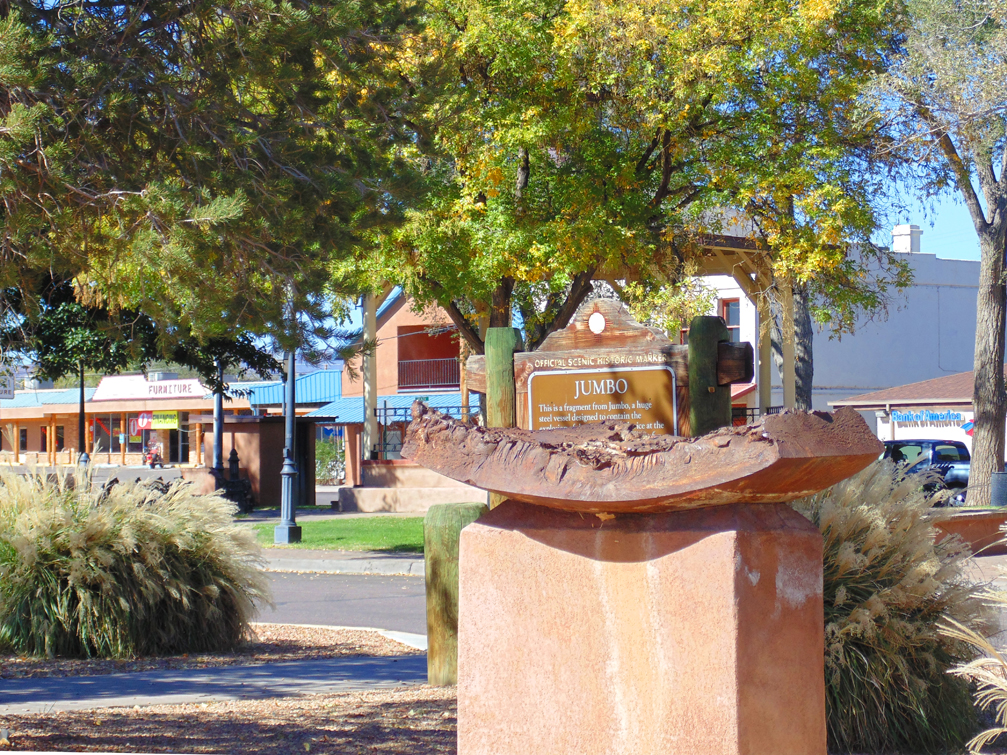
Visit Socorro New Mexico

- Skip to global NPS navigation
- Skip to this park navigation
- Skip to the main content
- Skip to this park information section
- Skip to the footer section

Exiting nps.gov
Alerts in effect, trinity site.
Last updated: April 10, 2023
Park footer
Contact info, mailing address:.
Manhattan Project National Historical Park c/o NPS Intermountain Regional Office P.O. Box 25287 Denver, CO 80225-0287
Hanford: 509.376.1647 Los Alamos: 505.661.6277 Oak Ridge: 865.482.1942
Stay Connected

UponArriving
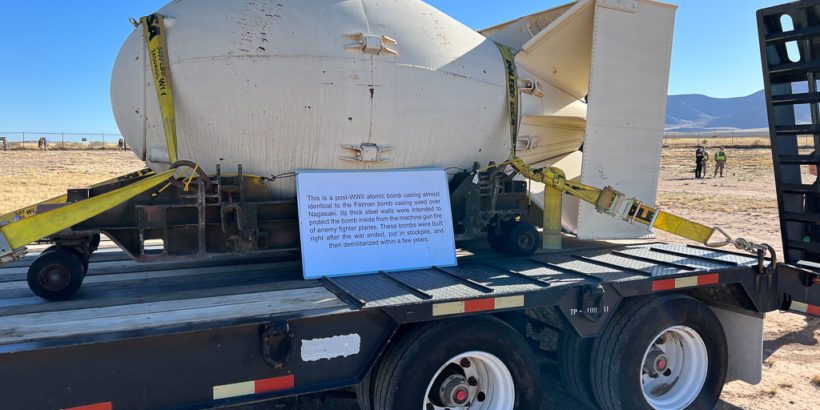
Trinity Site Open House Guide (New Mexico)
Over the years of turning out content for this blog, I’ve visited a lot of historical sites but I’ve never visited a site quite like the Trinity Site in New Mexico.
It’s an ultra-remote site barely ever open to the public and it’s home to one of the most pivotal moments in mankind’s history.
If you have any type of interest in the atomic era, this is a bucket-list worthy destination for sure.
In this article, I’ll tell you everything you need to know about visiting the Trinity Site’s open house.
Table of Contents
What is the Trinity Site?
The Trinity Site is where the first nuclear bomb exploded on July 16, 1945 at 5:29 AM mountain war time. Two days out of the year there is an open house that allows the public to visit the site along with other related sites like the McDonald Ranch House.
Tip: Use the free app WalletFlo to help you travel the world for free by finding the best travel credit cards and promotions!
How to visit the Trinity Site
It is free to visit the Trinity Site but you can only visit the site two days out of the yea r, which is usually the first Saturday of April and October. However, sometimes they do change the dates around a little bit.
There are three main ways that you can visit the Trinity Site.
Alamogordo Caravan
One way to experience the Trinity Site is to take part in the Alamogordo Caravan.
Line up for the caravan begins at 7:00am at the Tularosa High School Athletic Field parking lot and the tour will enter the missile range through the Tularosa Gate at 8:00am and arrive at Trinity Site around 10am.
It is only open to the first 125 vehicles that show up.
The journey is 85 miles one-way to Trinity Site.
Stallion Gate
The other way to experience the Trinity Site (which is the way that we did it) is to simply arrive at the Stallion Gate. This gate is located on the north side of the missile range on U.S. highway 380, 12 miles east of San Antonio, NM.
The Stallion Gate Hours are from 8:00 a.m. to 2:00 p.m. and the Trinity Site closes promptly at 3:30 p.m
Once you show up at the military testing site, you’re not allowed to take any photos until you arrive inside the Trinity site so keep that in mind.
It’s about a 30 minute drive from the Stallion Gate to the parking lot for the Trinity Site.
At the Stallion Gate, you’ll go through a security checkpoint where every passenger 18 years and older will need to show an ID and declare that they are not bringing in weapons or any illegal items. (It only takes a few seconds to get through.)
Once you arrive at the parking area, military personnel will direct you to your specific parking spot.
Related: New Mexico Safety Corridors Explained
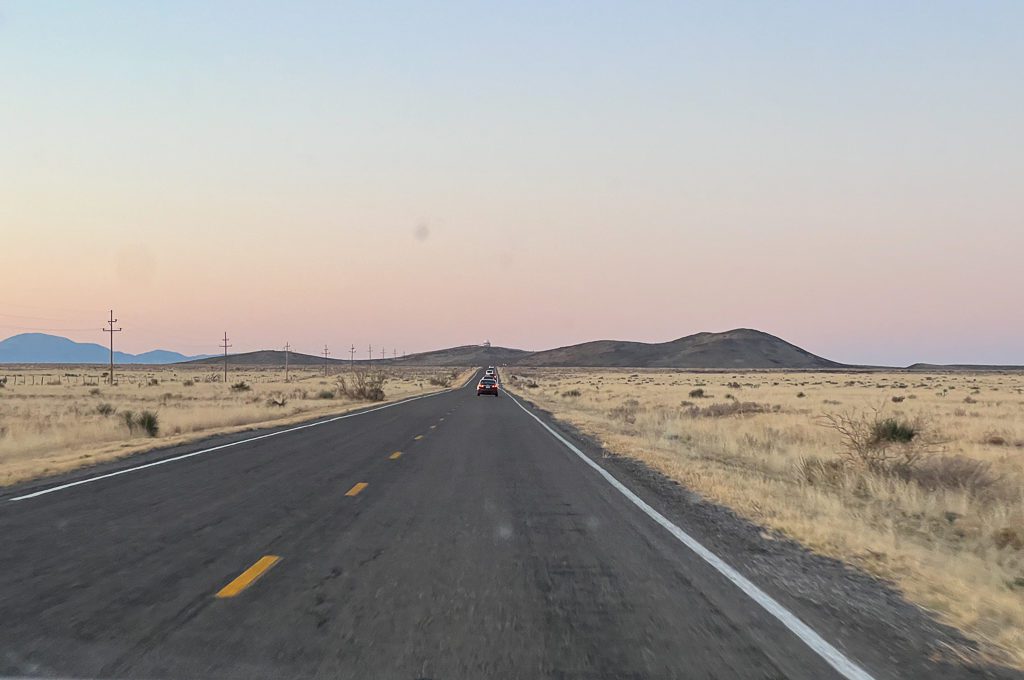
Book a tour
You can also book a tour to get you there.
For example, the New Mexico Museum of Space History offers a package deal where you can get a bus ride to and from the site, some snacks, and access to the museum.
We checked out the museum and thought that it was a pretty well done space museum. They also have a small exhibit on Trinitite which was cool to see.
Where to stay
You might consider staying in Albuquerque, New Mexico, or in Alamogordo which is where we stayed because we decided to explore the New Mexico Museum of Space History and White Sands National Park the next day.
If you’re headed to Albuquerque, be sure to check out The National Museum of Nuclear Science & History and consider adding Los Alamos as an additional stop.
Los Alamos was the headquarters for the Manhattan Project and they still have a couple of museums you can check out like the Los Alamos History Museum and the Bradbury Science Museum .
Trinity Site history
To fully grasp and appreciate the history of the Trinity Site it helps to understand how it fits into the overall efforts of creating the atomic bomb.
The history of the atomic bomb begins in Berlin, Germany when in 1938, scientists discovered how to split the nucleus of the uranium atom (fission).
This discovery came close to the beginning of World War II when Adolf Hitler invaded Poland in September 1939.
The breakthrough in fission created serious worry that the Nazis would get their hands on a nuclear weapon which would obviously not be ideal to say the least.
Concerned Hungarian physicists helped write a letter to President Roosevelt (FDR), signed by none other than Albert Einstein, to warn the US about the prospect of an “extremely powerful” Nazi atomic bomb.
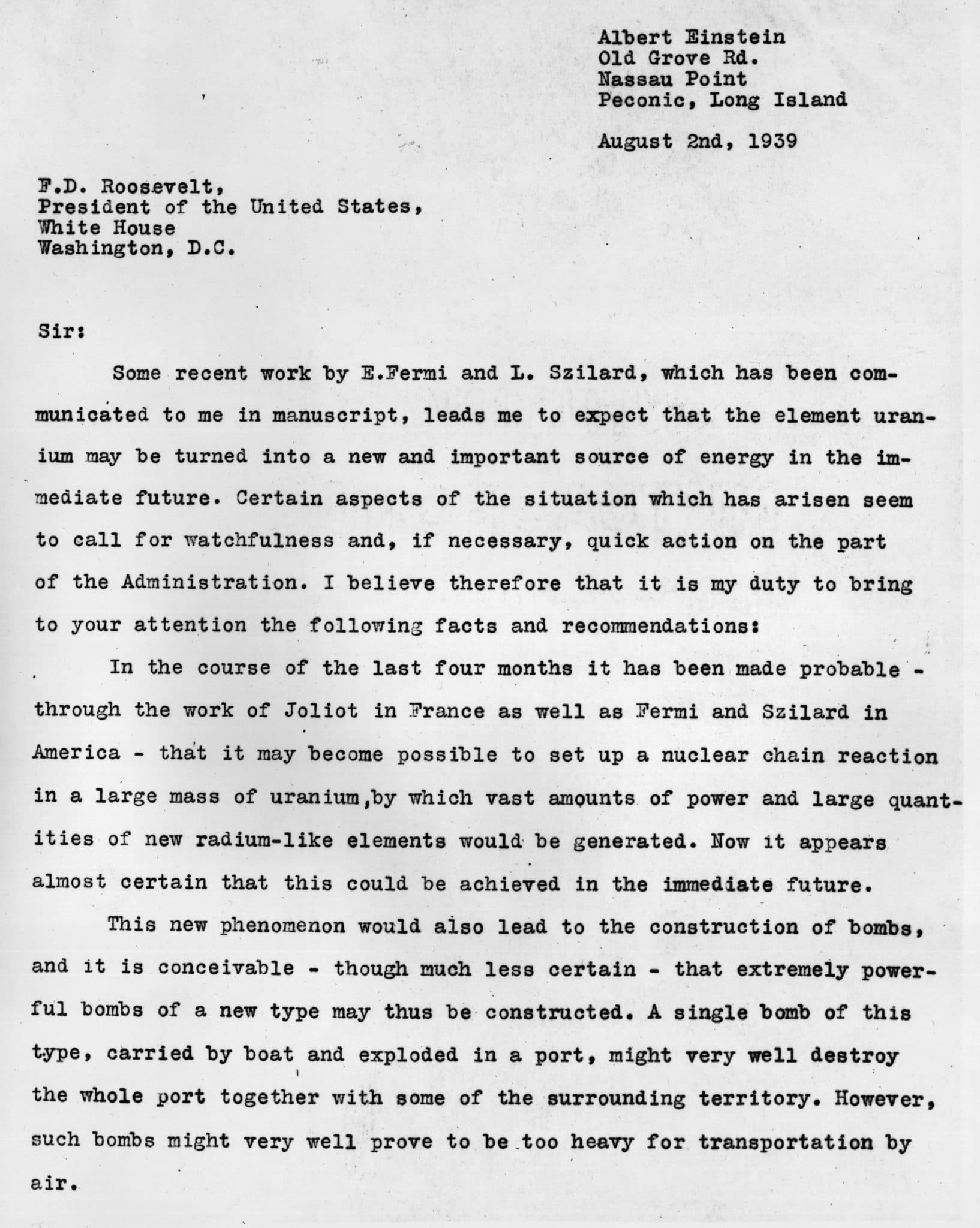
After that, it didn’t take long for FDR to authorize a top-secret project to begin researching the atomic bomb.
The initiative went through a few name changes but ended up as the: Office of Scientific Research and Development (OSRD).
Things took off after the bombing of Pearl Harbor on December 7, 1941 when the US found itself involved in World War II with a formal declaration of war on both Japan and Germany.
President Roosevelt authorized the Manhattan Project on December 28, 1942 and on the 18th floor of 270 Broadway in New York City, the Manhattan Project began.
General Leslie Groves was appointed to lead the Manhattan Project after just just finishing the completion of the Pentagon.
Groves went on to recruit Robert Oppenheimer, an instructor at the University of California at Berkeley and a bit of an odd selection given his lack of managerial experience and associations to communism via family members.
But he proved to be an ideal candidate and an excellent recruiter of scientific talent.
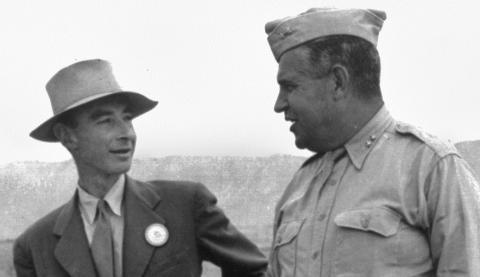
The Manhattan project sought to create atomic bombs from two substances: uranium and plutonium.
For uranium, they were focused on acquiring U-235 and they built a huge complex and town in Oak Ridge, Tennessee to accommodate 30,000 workers .
For Plutonium, the Hanford Engineer Works produced plutonium at a site along the Columbia River in Washington state.
They also needed a place to develop and test the bombs.
They wanted somewhere secret and remote but still appealing enough to attract renowned scientists all over the world so they went with Los Alamos, New Mexico.
On January 1, 1943, the Los Alamos Laboratory — known as Project Y — was formally established .
And a few months later , the University of California signed a contract with the United States Army Corps of Engineers to operate the secret laboratory.
They once again built an entire city just for the purpose of the Manhattan Project and hundreds of people would arrive to the city with no clear idea as to what they were actually building.
(Pretty much only scientific personnel had an idea of what they were doing.)
Questions were highly discouraged and on paper the city didn’t actually exist.
Many experiments were done as the teams collaborated to construct the bombs and waiting for the nuclear material to arrive. At some point, though, it became clear that the plutonium bomb was going to be an issue.
The issue was that creating an explosion with plutonium was a much more complicated process.
The scientist had to create an entirely different type of mechanism to initiate the chain reaction and that’s when they came up with implosion.
The implosion-type nuclear weapon , “held a core of subcritical plutonium which would reach criticality when high explosives surrounding the core detonated causing the core to compress instantly.”
The creation of this new type of work and was so challenging that it required bringing in a lot more scientists. Unfortunately, when bringing in more talent at least one Russian spy made his way into the team.
The team would ultimately make progress but unexpected challenges arose in April 1945 and the work was interrupted when FDR died in office.
Shockingly, the Vice President Harry Truman did not even know about the Manhattan Project when he took office!
A month later, on May 7, 1945, Germany would surrender but the war was still going strong in the Pacific Theater and an atomic weapon was being considered for use against the Empire of Japan.
The allies had battered the Empire of Japan’s military down to a shadow of what it had been before but casualties were still running very high.
But before any bombs would be dropped, some testing needed to be done.
Testing at the Trinity Site
Back in September 1944, around the time nuclear material was arriving, New Mexico’s Alamogordo Bombing and Gunnery Range (aka the Trinity Site) had been selected as the the test location .
It was located about 210 miles south of Los Alamos, and in November 1944 construction of the base camp began.
All of the components of the uranium atomic bomb had been tested giving scientists the mathematical certainty they needed to know that the bomb would work.
But because the plutonium bomb was more complex they needed a test run to ensure that it would work.
The plutonium bomb set to be tested at the Trinity Site was known as “Gadget.”
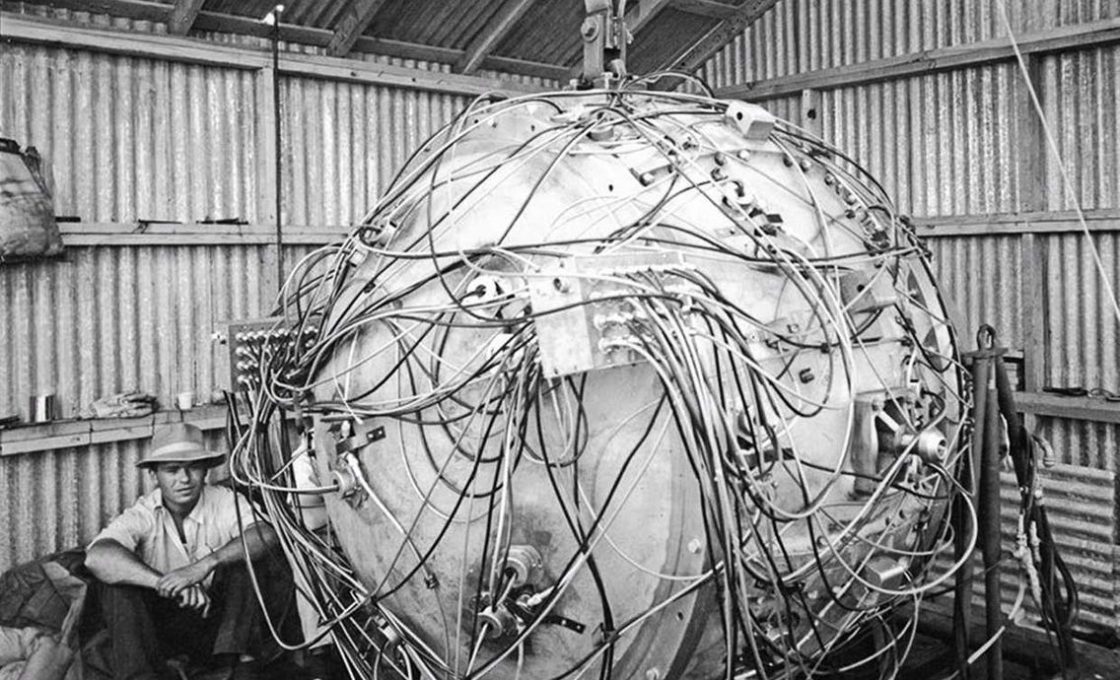
The core of the bomb consisted of a grapefruit-sized ball of plutonium and was delivered to the McDonald Ranch House on July 11, 1945 and the bomb was assembled on July 13, 1945.
The bomb, a large 6-foot sphere covered with wires and patched up with tape, was then hoisted up a 100-foot steel tower for the test.
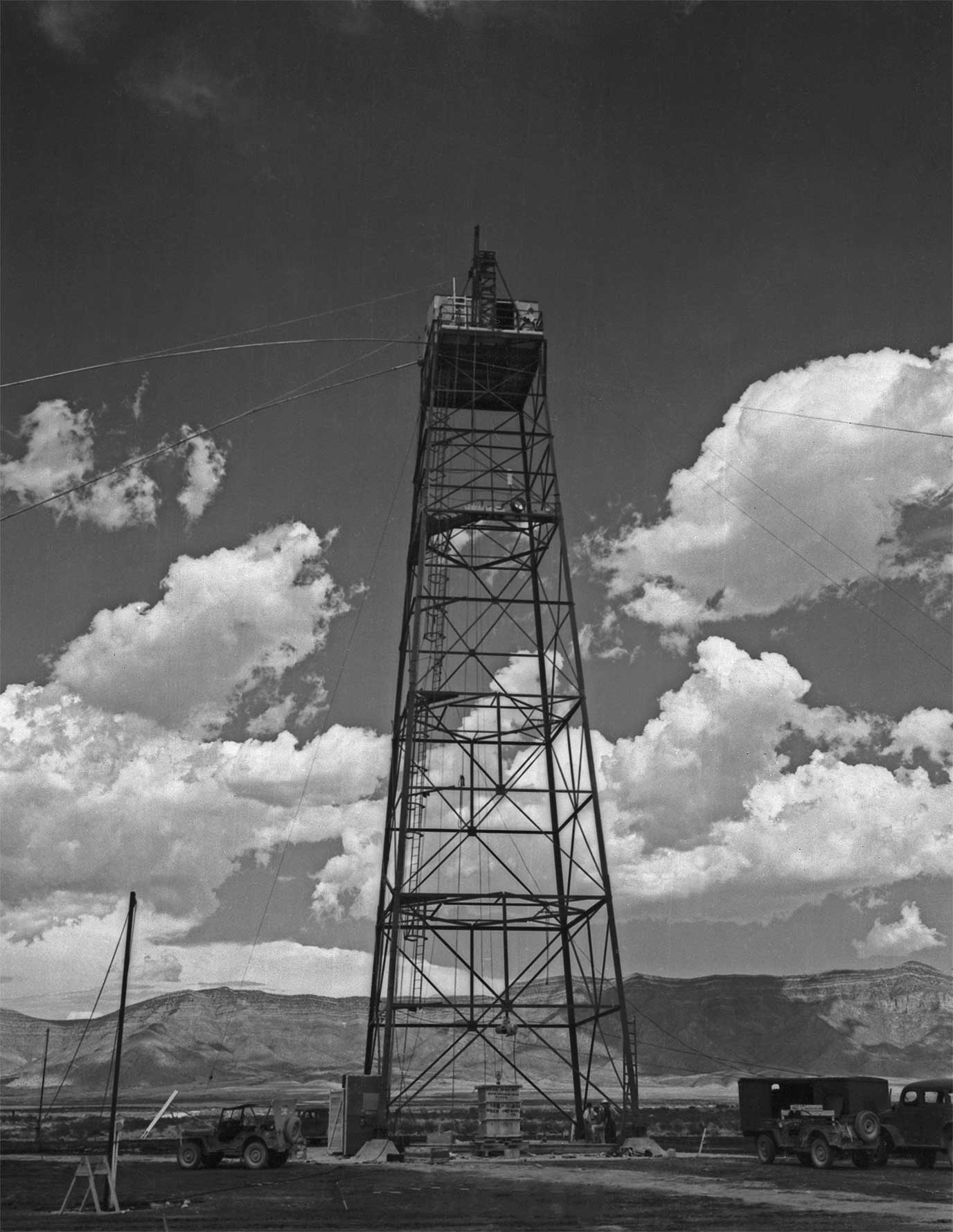
At the time, none of the scientists truly knew what was going to happen. In fact, many thought the bomb would be a dud.
On the day of the test, the weather did not cooperate at first and the team postponed the test until the skies cleared up a little bit.
Then at 5:29:45 a.m. Mountain War Time on July 16, 1945, first atomic bomb was tested .
After the bomb exploded, clouds of bright reds and purples filled the sky up to 40,000 feet high. People said they felt the warmth of the sun.
Local newspapers were told that an ammunition depot had exploded which had resulted in the spectacular display but those at the site knew the truth: humankind had entered the atomic age.
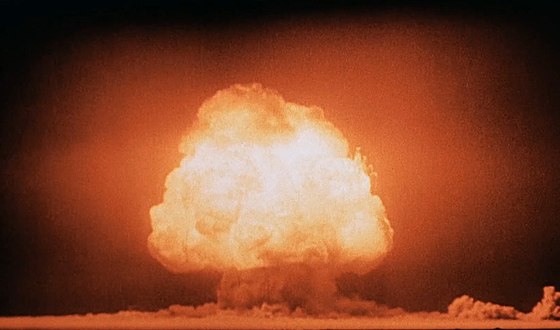
The Trinity site
Ground zero.
Ground Zero is about a quarter mile away from the parking lot so you have to walk a little bit to get there.
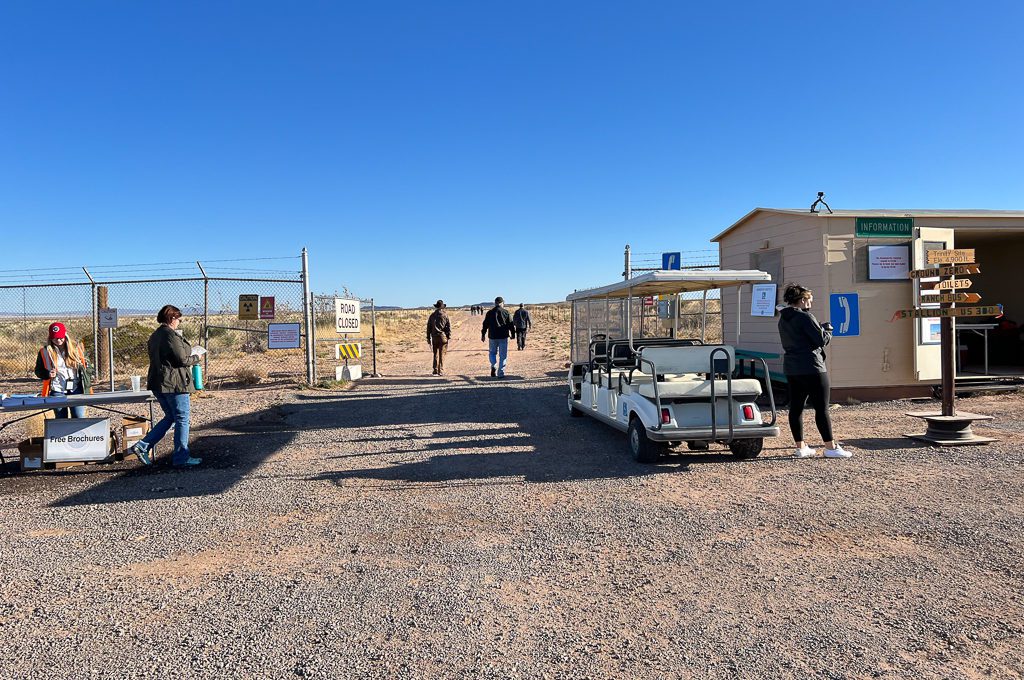
Once you arrive, you’ll see a monument towering in the middle.
Erected in 1965, The Trinity Monument is a lava-rock obelisk about 12 feet (3.7 m) high that marks the explosion’s hypocenter.
Crowds gather around the monument pretty quickly so you might need to exercise some patience to get a photo.
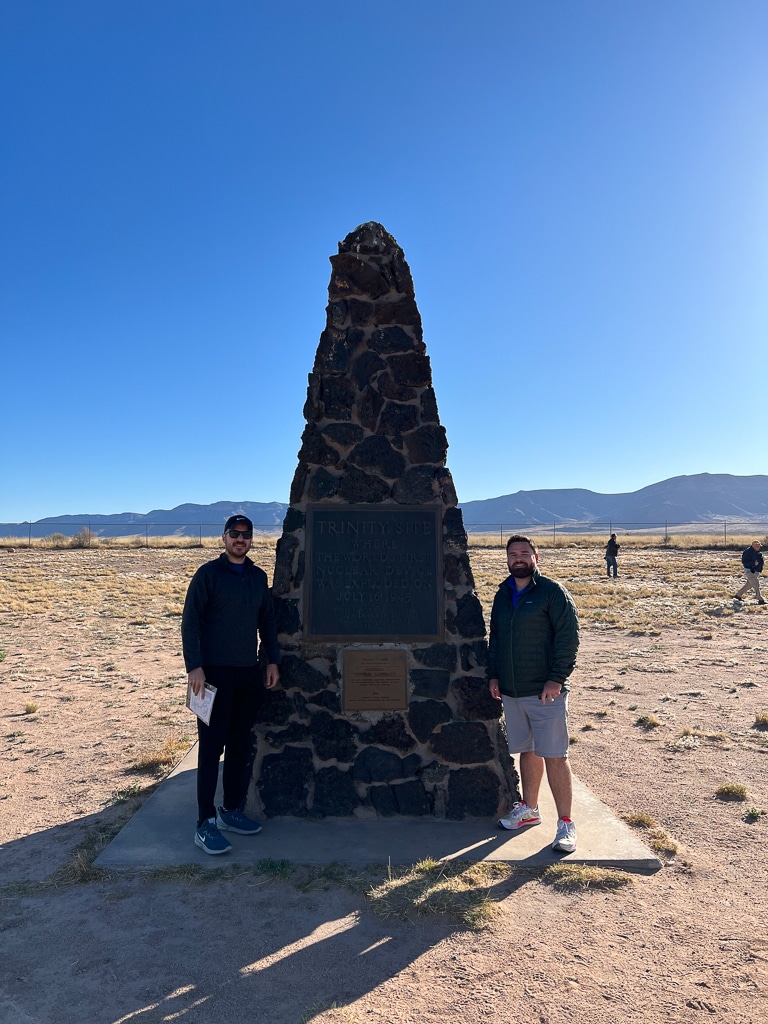
Right next to the obelisk, you can find the remains of the 100 foot steel tower that hoisted Gadget.
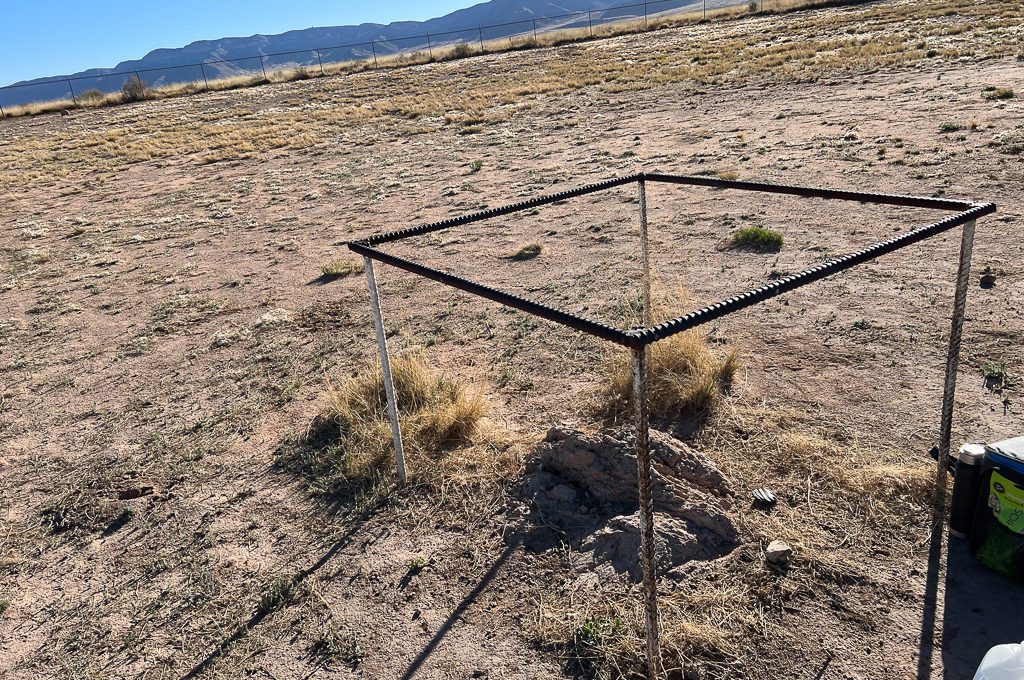
Along the perimeter of Ground Zero, you’ll find photos hanging from the fence that will give you some insight into everything going on at the time of the test. It’s best to start from right to left when viewing these.
There’s a structure that covers some of the original soil from the test but sand and dust got in and covered up the original soil so the viewing window has been closed.
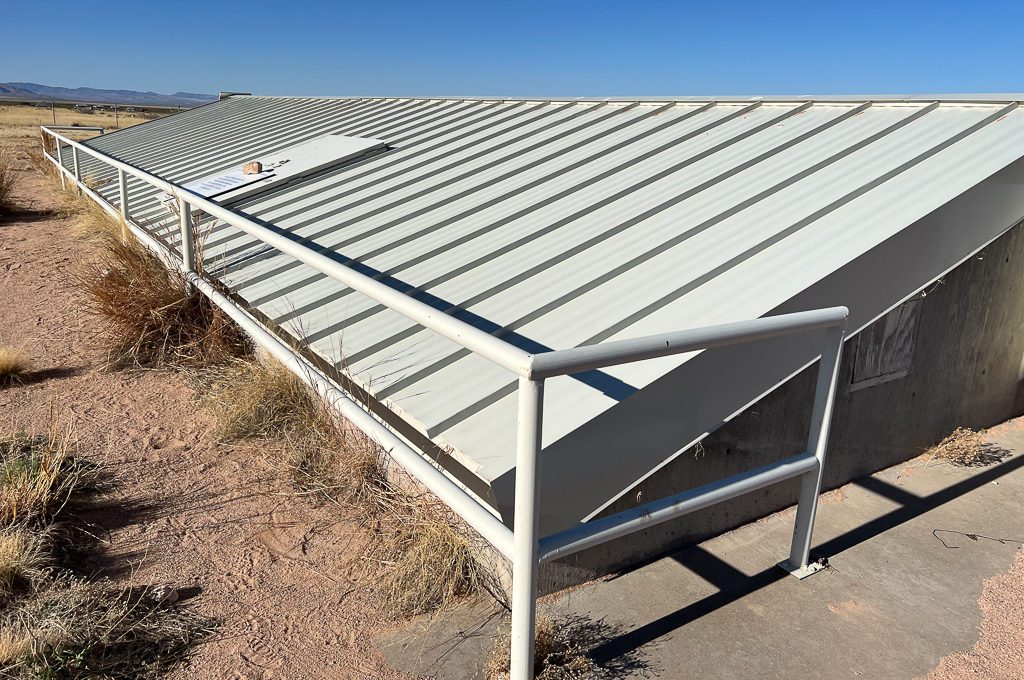
There’s also a bomb casing that I believe was going to be used for future atomic bombs. It’s almost identical to the casing used for the fat man bomb which was dropped on Nagasaki.
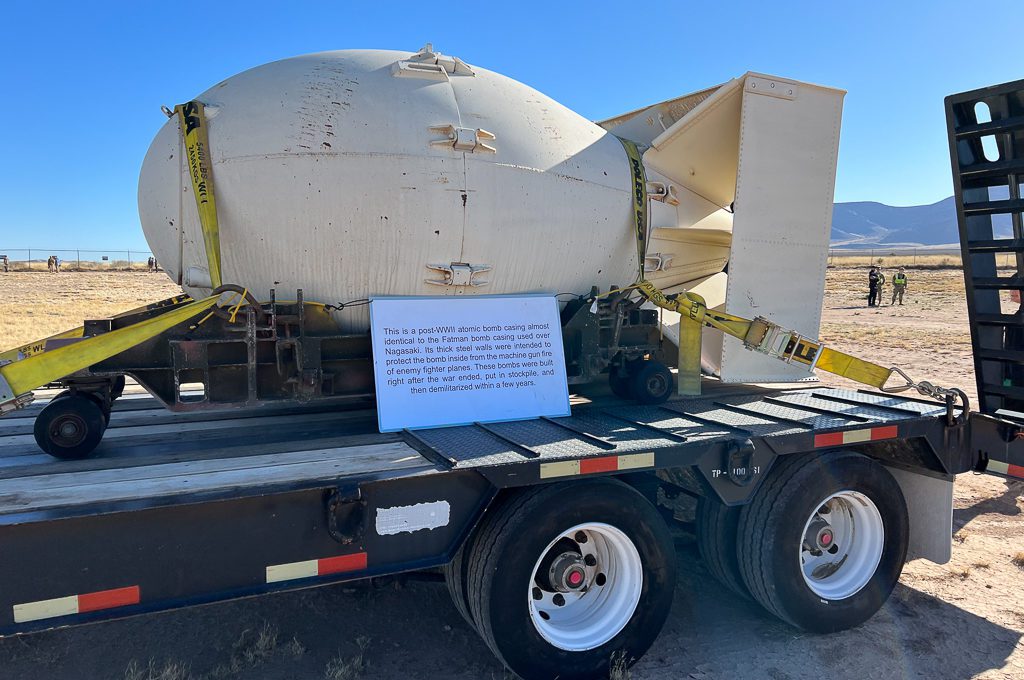
Trinitite is a radioactive green glass-like substance that covered the depressed area where the explosion took place after the test.
There’s different explanations as to how the trinitite was formed.
The simple and long-held explanation is that the heat simply heated the sand until it became glass.
One hypothesis is that the explosion brought pieces of sand and rock into the fireball and liquefied the pieces which eventually fell down like rain into the crater and hardened.
I’m not sure which explanation might be more accurate but I think it’s safe to say that it had a lot to do with the heat from the explosion.
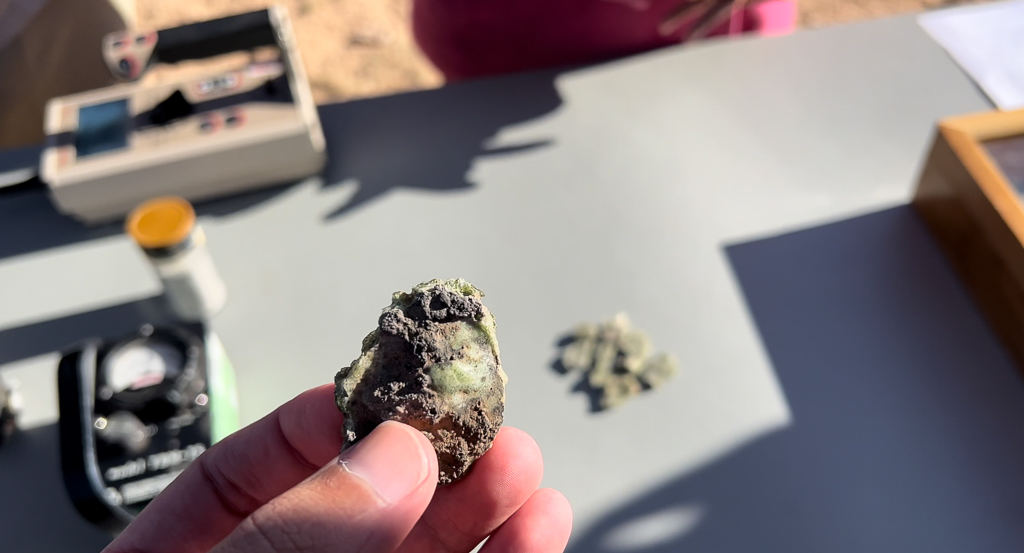
Most of the trinity it is light green but other pieces are slightly different colors. Some are black and others look slightly red and that’s because those contain elements that were vaporized during the test.
For example, the black pieces contain elements from the steel tower and the red pieces contain elements from the copper in the wires.
If you stroll around Ground Zero and look closely at the ground it won’t be very difficult to find pieces of trinitite.
They possess background levels of radiation and you are okay to touch them but probably not a good idea to do something stupid with them like swallow them. It’s also a federal crime to remove them from the property.
You’ll also want to stop by the trinitite fueling station. Here, you can get a close look at trinitite and also use a geiger counter to detect the radiation levels of the trinitite.
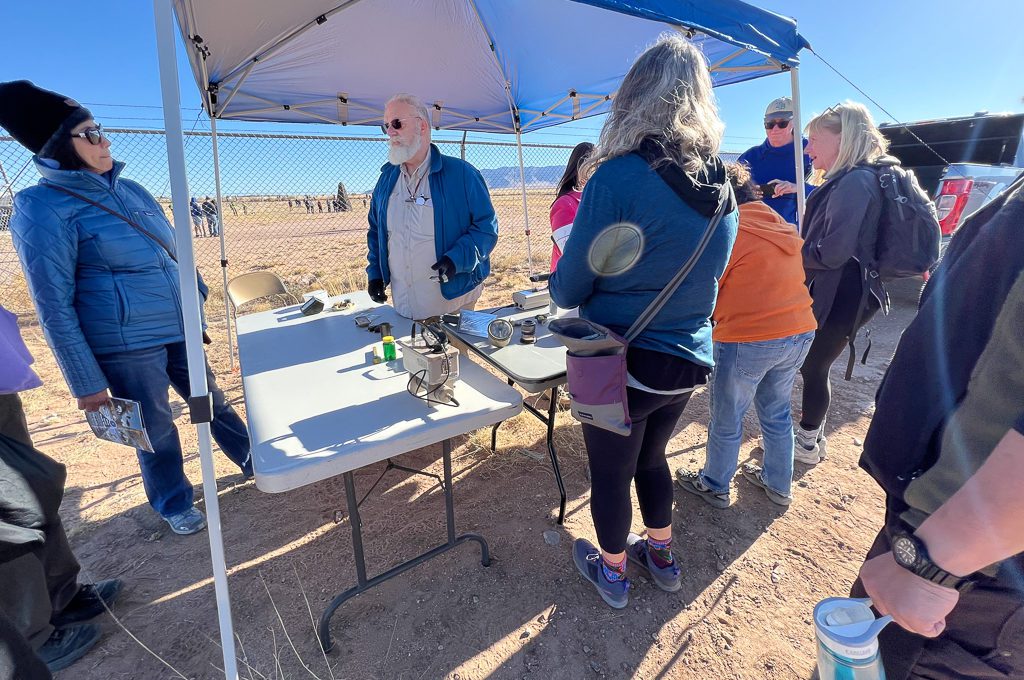
McDonald Ranch House
The McDonald Ranch House is where they assembled the bomb on July 13, 1945. Built in 1913 by Franz Schmidt, a German immigrant and acquired by the McDonald family in the 1930s, the ranch was eventually taken over by the government in 1942.
In order to get there, you need to head to the bus stop which is located right by the parking lot. It’s only about a 5 to 10 minute bus ride to get to the ranch house. Keep in mind that dogs are not allowed on the bus unless they are service animals.
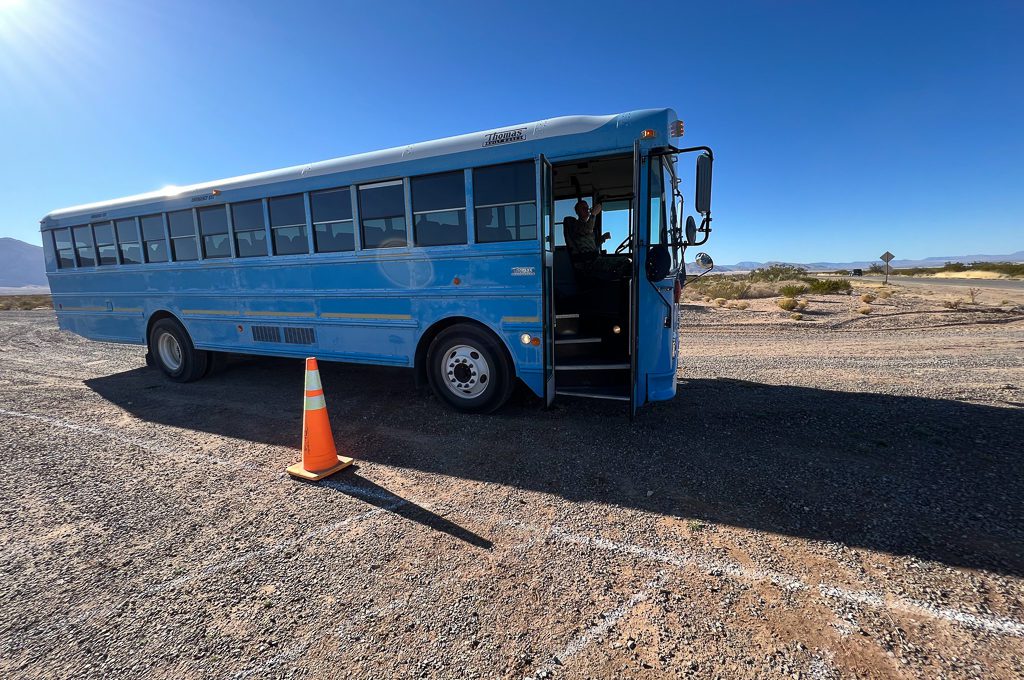
When you arrive, you can simply wander through the McDonald Ranch House at your own pace. There should be somebody inside that can help answer any questions you might have and who can show you around.
They also had a table with photographs set out in front so you can learn a little bit more about the structure.
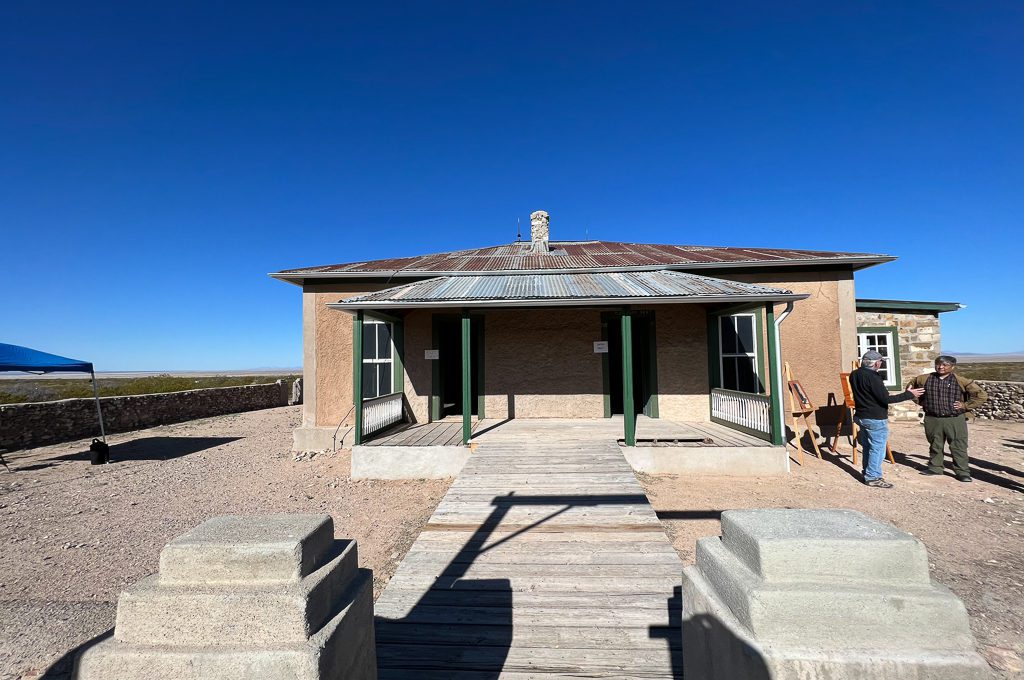
The northeast room was designated the assembly room where they had work benches and tables.
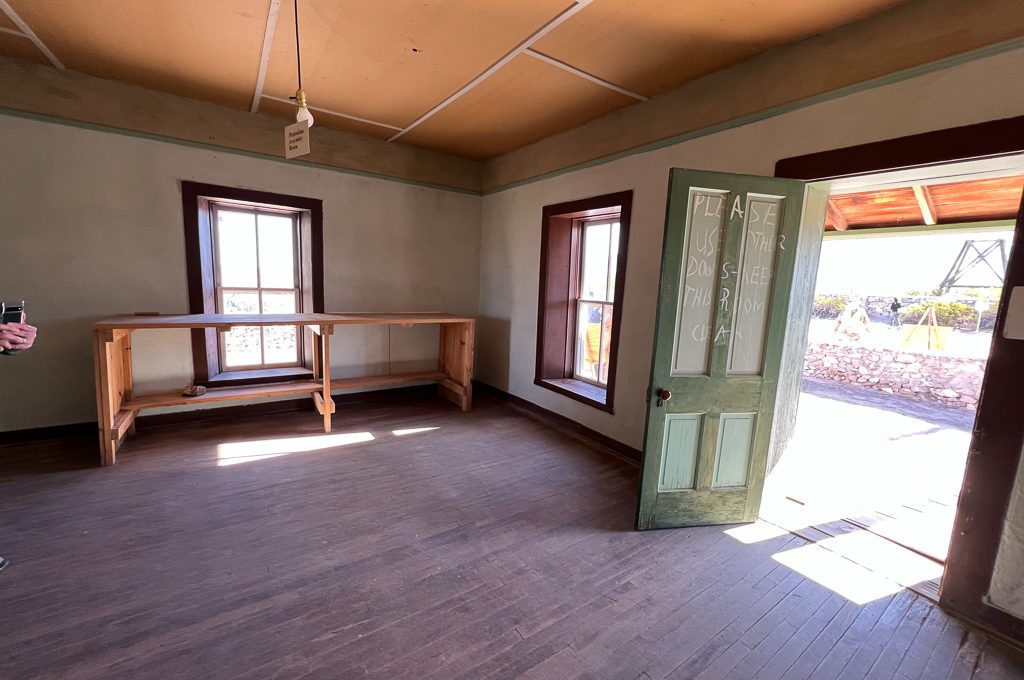
To keep all of the sand and dust from ruining the instruments, they covered the windows and walls with plastic. In fact, you can still see some of the nails that were used to seal up the windows.
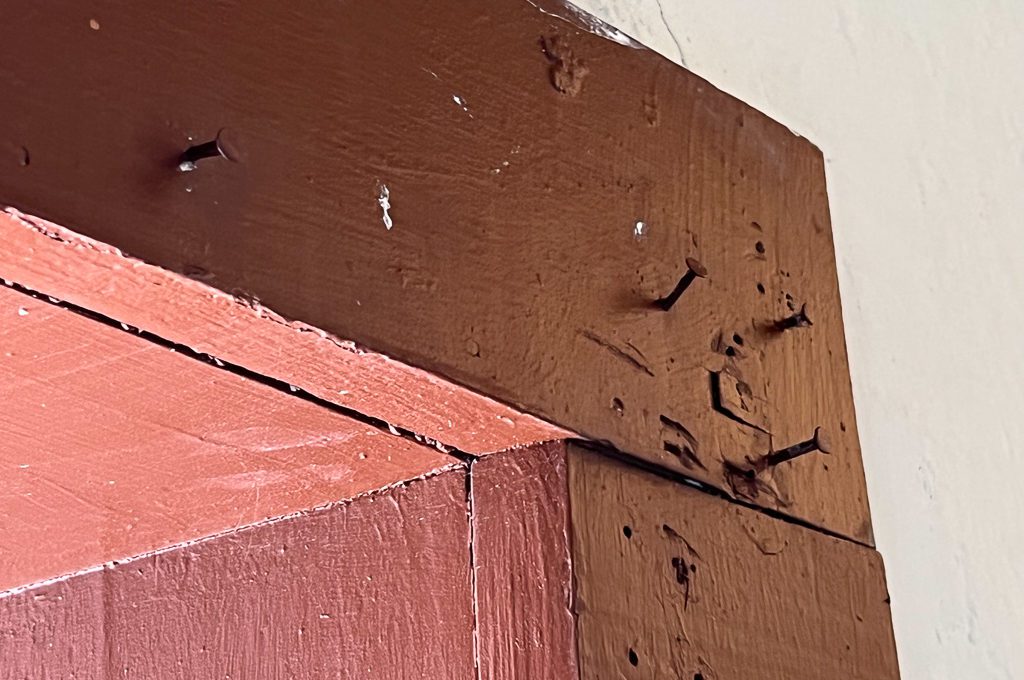
As mentioned above, the plutonium core was delivered to the ranch house on July 11, 1945 and it was assembled on July 13, 1945.
The explosion occurred only 2 miles (3.2 km) away and it blew most of the home’s windows out but did not significantly damage the structure.
Instead, it was the years of rain water leaking through the roof that was responsible for the deterioration.
In 1984 it was restored by the National Park Service to appear as it did on July 12, 1945
Near the main parking lot you’ll see Jumbo which is a large structure which was once the heaviest object to ever be transported by rail.
The 25-foot jumbo container was initially going to be used to contain the plutonium with its 14 inch thick walls in the event of a botched explosion.
However, after they realized that they would have plenty of plutonium for additional bombs they didn’t need to use jumbo for the explosion.
So they hoisted it from a tower about 800 yards away from ground zero and while that tower would be vaporized during the explosion, jumbo would remain intact.
While they did not use it for this explosion, it was used on April 16, 1946, when an Army ordnance team detonated eight 500 lb bombs in the bottom of the steel container.
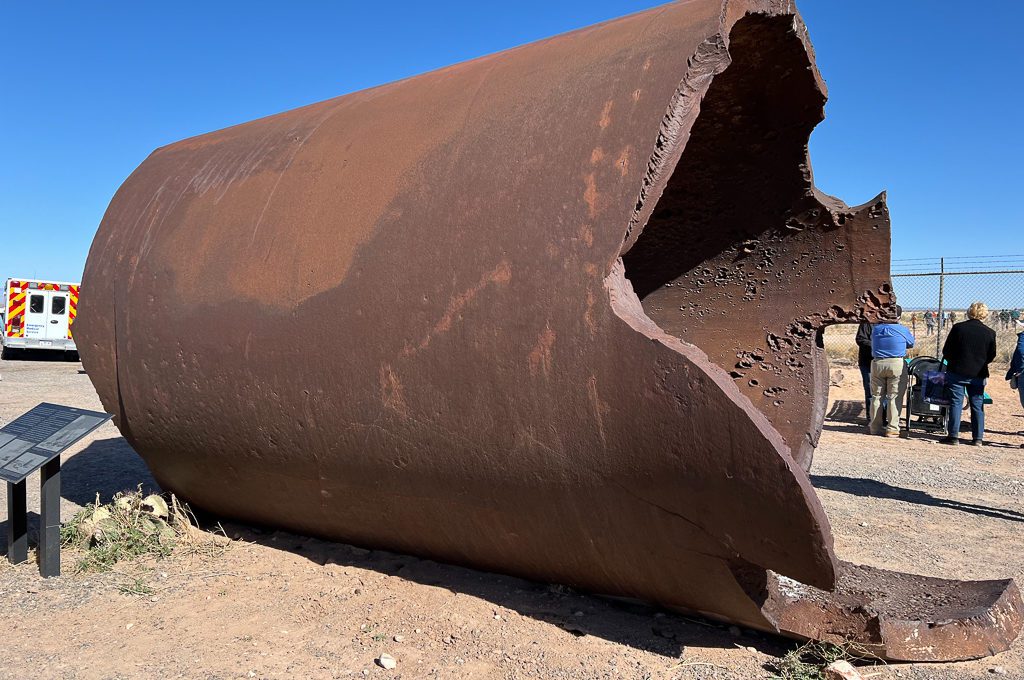
Food and souvenirs
You’ll also be able to find food and souvenirs at the Trinity site.
Souvenirs range from about $3 to $20 and they have a lot of the typical stuff like magnets, stickers, patches, and T-shirts.
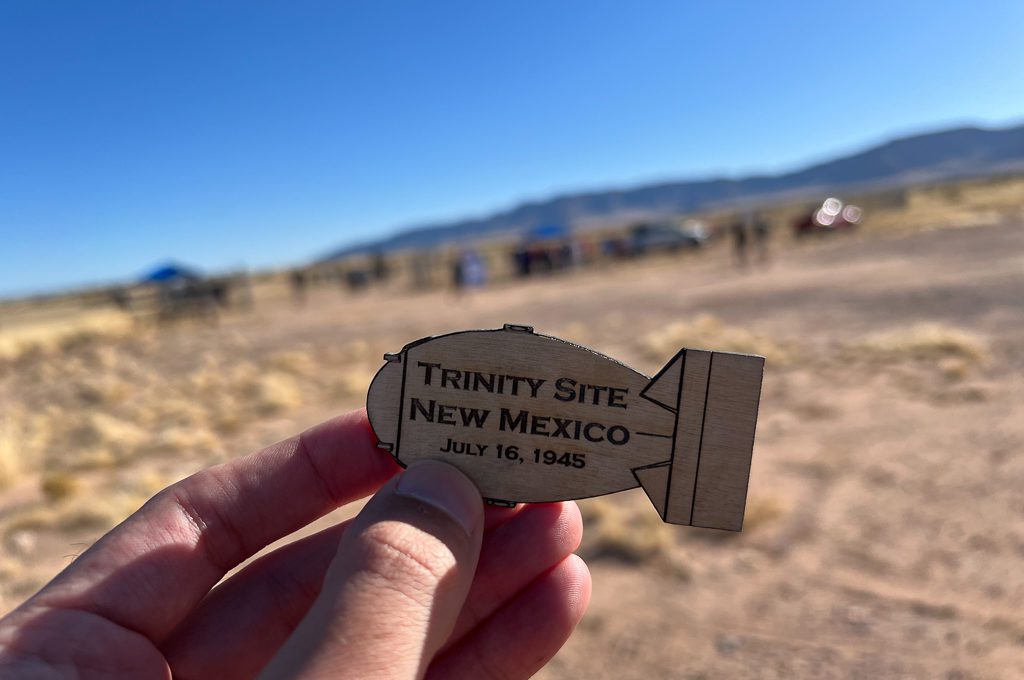
As for food, they’ll have breakfast burritos, hamburgers, hotdogs, and some other snacks. I believe the registers should take credit cards but I would bring cash just in case.
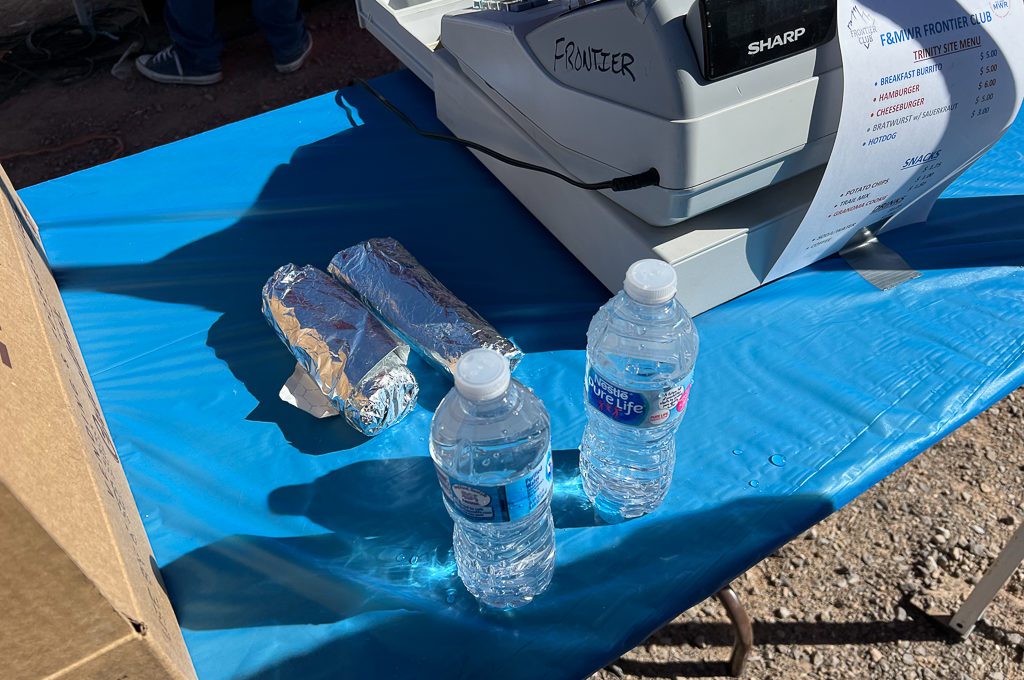
Also, they do have bathrooms which are a little bit of a walk from the parking lot.
Visiting the Trinity Site is not very easy because it is only open two days out of the year and it’s basically in the middle of nowhere.
But it is still absolutely worth planning out a visit because it’s hard to find a location that compares to the Trinity Site in terms of its importance to the history of mankind.

Daniel Gillaspia is the Founder of UponArriving.com and the credit card app, WalletFlo . He is a former attorney turned travel expert covering destinations along with TSA, airline, and hotel policies. Since 2014, his content has been featured in publications such as National Geographic, Smithsonian Magazine, and CNBC. Read my bio .
very informative. i am planning a visit in october 2023. was wondering about the mcdonald ranch house, and you answered all my questions…. this trip in october will knock off another event on my bucket list.
July 2023: The tour package is now $150 per person.
Confused. Sorry. From a that I see it’s free to drive and take pictures of the monument and see site from distance What is the 150.00 Charge for. It’s free to drive up and see site frown distance Can I also see McDonald house for free. Please advise. Coming from Dallas How can I get free brochures for trinity mailed to me on trinity testing Came I get a number to call. Please let me know.
Leave a Reply Cancel reply
Your email address will not be published. Required fields are marked *
Privacy Overview
Alamogordo, New Mexico True
Type and press enter to search
Trinity site.
www.wsmr.army.mil/Trinity
The world was forever changed on July 16 th, 1945 at the Trinity Test Site. It was here at the White Sands Missile Range that the first atomic bomb was detonated and brought a quick end to the Second World War in the Pacific. Today it is a national historical site that is open to visitors just 2 days per year, (pending Army approval) in April and October. Visitors can see ground zero, the ranch house where the bomb was assembled, and one of the instruments bunkers. For more information about visiting the site go to www.wsmr.army.mil/Trinity
History of Trinity Site www.nps.gov/whsa/learn/historyculture/trinity-site.html
You have a few different options when it comes to visiting Trinity Site. You can enter through the Stallion Gate which is off of Hwy 380 between Carrizozo and San Antonio, NM at the times specified on the White Sands Missile Range website. You can also caravan into the site, this route takes you from Tularosa, NM through the Missile Range with other travelers. To participate in the caravan you need to meet in the Athletics parking lot on the west side of the Tularosa High School off of La Luz Ave. Line up starts at 7 am and the caravan will leave promptly at 8 am. Please arrive no later than 7:45 am so that officers will have a chance to check your license and registration, and give you a pass to place in your window signifying that you are a part of the caravan. You may return to Tularosa with the caravan between 12:30 and 1 pm, or leave on your own through the Stallion Gate. Please ensure that you have a full tank of gas and bring plenty of water with you. Finally, the International Space Hall of Fame Foundation (New Mexico Museum of Space History support group) hosts a guided tour to the site in charter buses, they also provide b a sack lunch, water, and a guide tour of the museum upon return.
Find more info and register for the guided tour at http://nmspacetrail.com/sites/NMMSH/Trinity-Site-Tour/register.html For more information about the caravan lineup https://www.alamogordo.com/trinity-site / New weekend itinerary coming soon!
NEW!!! The Tularosa Basin Museum of History is hosting a viewing followed by a Q&A, of the new documentary, 'Alamogordo, Center of the World, Trinity 1945' the Friday evening before each open house. Tickets are available through the museum at the corner of White Sands Blvd & 10th, 575-434-4438. The film will be shown at the historic Flickinger Center for Performing Arts (1110 New York Ave. Alamogordo, NM) in downtown Alamogordo. For more info call 575-437-2202.
Directions to Trinity Site: http://www.wsmr.army.mil/Trinity/Pages/DirectionsMaps.aspx

More information about the caravan to Trinity Site visit www.alamogordo.com

Map to caravan lineup site, limited to 125 vehicles.

clock This article was published more than 10 years ago
A visit to Trinity, where the first A-bomb was tested in 1945, turns up radiation still
The sun was rising as a teenage boy swung a metal wand back and forth, back and forth. The Geiger counter hanging at his waist clicked, testifying to the radiation streaming from the ground and through his body.
The White Sands Missile Range in the New Mexico desert is home to Trinity, the place where the nuclear age began on July 16, 1945. Twice a year, in April and October, the site has opened to the public. Each time, thousands of people arrive by Winnebago, motorcycle and tour bus, making a pilgrimage to check out the slight crater left by history’s first atom bomb test. Measuring just 340 feet across, the depression is underwhelming, a slight dent in the ground. A stone obelisk marks ground zero, where the bomb was detonated atop a 100-foot steel tower.
The Trinity weapon, a version of which destroyed Nagasaki on Aug. 9, 1945, used plutonium. That fuel was more far more efficient than the uranium in the bomb dropped over Hiroshima on Aug. 6, but it was thought to be less certain to work.
When TNT in the Trinity device exploded, it compressed plutonium atoms inside. This set off a non-plutonium source of neutrons that split some of the plutonium atoms, triggering a chain reaction that led to the massive explosion and now famous flash of light and mushroom cloud.
J. Robert Oppenheimer and the other physicists who assembled the bomb's core in a ranch house on-site, using tape and plastic sheets to keep the dust out, took bets on whether this process would work. No one knew how big the explosion would be if it did happen. In the end, the blast was equivalent to about 19 kilotons of TNT going off at once, and people nearly 200 miles away felt the force or saw the flash. (An official statement released in response to many concerns stated that "a remotely located ammunitions magazine containing a considerable amount of high explosives and pyrotechnics exploded" but that "there was no loss of life or limb to anyone.")

After rupturing, the plutonium atoms transformed into a host of radioactive elements. Some, such as a form of iodine, dissipated quickly. Those still present in the sandy soil of Trinity in significant quantities today tend to be entities that will stick around for a long time, such as cesium-137, europium-152 and europium-155. One particularly long-lived isotope has a half-life of 24,100 years.
Counting the clicks
When the teenage boy swept his Geiger counter back and forth near ground zero, the instrument showed he was getting about half a millirem of radiation per hour from these materials. That measurement squared with official readings from safety officials who regularly sweep test the site and haven’t seen much change from year to year. At that rate, a two-hour visit delivered a dose of alpha particles and gamma rays equal to about a tenth of the radiation that a person soaks up during a chest X-ray.
My own Geiger counter, a yellow metal box stuffed with Cold War-era circuits, proved to be a better conversation starter than scientific instrument. As I wiggled the knobs, the needle refused to budge. That turned out to be a good thing.
“If that needle were moving right now, we’d all be dead soon,” radiation hobbyist Jim Hill told me as I struggled to get a reading. This particular model had been designed to detect only extreme radiation, he said, such as the high levels present in the immediate aftermath of a nuclear explosion or meltdown.
Hill has a long personal history with the bomb.
When the mushroom cloud billowed up, he was 18 months old and living in Albuquerque, about 100 miles away. Army officials knocked on his family’s door and said they wanted to check on his health. Every six months afterward, all through his childhood, they showed up to check on him. He has never seen the report that he suspects the military officials were compiling on the effects of radiation on people. He said that so far he has hasn’t noticed any health problems due to the bomb.
An ant mound
Brandishing his own radiation reader, Hill led the way to a particularly hot spot: an ant mound. As he passed his baton over the pile, the instrument clicked faster; the reading jumped by about 25 percent.
Ants play a special role in research being conducted at Trinity by retired physicist Robb Hermes of Los Alamos National Laboratory, a four-to-five-hour drive away.
When Hermes first visited the site as a tourist in 2003, he noticed fragments of what looked like green glass littering the ground. It was a mineral called trinitite, formed by the blast and thus named for the site.
Taking some home would have been a federal crime — as a sign at the entrance to Trinity warns — so Hermes called up White Sands officials and requested some ant hill sand. The industrious insects travel large distances to gather mineral grains for the walls of their homes. Chances were good that some of those grains would be trinitite.
“The ants don’t care about the radiation,” said Hermes. “They just care about gathering the beads.”
Hermes doesn’t care much about the radiation, either. He grabbed a handful of nickel- and quarter-size trinitite chunks for visitors to see as he explained his work. What interests him is the spherical shape of trinitite beads he has found in the ant sand, a shape that has revealed how the beads formed during the split second after the bomb detonated.
If the waves of heat issuing forth from split atoms had seared the sand like a creme brulee, as Hermes and many others have assumed, the mineral should have formed in sheets. Spheres and bubbles of trinitite, though, suggest that the blast lifted sand into the air, melted it and then showered droplets over a wide area.
Remnants of vaporization
Poking around outside the fence a day before the masses arrived for the open house, Hermes found trinitite hurled more than mile from the blast, visible on the ground. He suspects that many of the trinitite pieces he has found contain remnants of equipment used in the test.
Dark green hues in some of the pieces may be remnants of the vaporized tower that cradled the bomb, he surmises. Other pieces stained red contain residue of the copper wires that connected the bomb to instruments in bunkers.
His ant sand, described in the Trinity brochures handed out to tourists, has also proved useful to scientists who study meteorites. Microscopic balls that have turned up at possible meteorite impact sites around the world are not trinitite beads, but they have a similar shape. They might be the remnants of a hail of space stones that pelted the planet about 13,000 years ago, bursting in midair and melting the ground like miniature nuclear warheads.
Debris hurled into the sky by those explosions might have dimmed the sun and triggered conditions similar to a nuclear winter. The timing coincides with the start of the Younger Dryas, a cold snap that lasted more than 1,000 years.
Hermes and his team of international collaborators, among them a nuclear scientist and several geologists, believe that the cold conditions were triggered when a meteorite slammed into Earth, leading to the extinction of large mammals across North America and to lean times during which hunter-gatherers turned to organized agriculture.
This theory is quite controversial; most scientists credit the sudden drop in temperature to ash belched out by volcanoes.
“The subject has become very contentious,” says Mark Boslough, a physicist at Sandia National Laboratories who studies airbursts and isn’t convinced by the evidence gathered so far. Radiocarbon dating of some of the samples suggests they are far too young to fit the theory, forming a mere hundreds of years ago.
But if Hermes and his team are right, the Trinity site may hold a significance beyond its role in the beginning of the nuclear era. It may also provide a window into understanding an important chapter in the history of humanity and the planet itself.
“The Trinity site gives us a way to study air bursts,” Hermes said. “Many impacts [thousands of years ago] could have created a situation similar to nuclear winter.”
Powell is a Washington-based freelance science reporter.

- Cover Letters
- Jobs I've Applied To
- Saved Searches
- Subscriptions
Marine Corps
Coast guard.
- Space Force
- Military Podcasts
- Benefits Home
- Military Pay and Money
- Veteran Health Care
- VA eBenefits
- Veteran Job Search
- Military Skills Translator
- Upload Your Resume
- Veteran Employment Project
- Vet Friendly Employers
- Career Advice
- Military Life Home
- Military Trivia Game
- Veterans Day
- Spouse & Family
- Military History
- Discounts Home
- Featured Discounts
- Veterans Day Restaurant Discounts
- Electronics
- Join the Military Home
- Contact a Recruiter
- Military Fitness
Army Cancels Planned Public Visits to Trinity Bomb Site in April. You Can Blame 'Oppenheimer.'
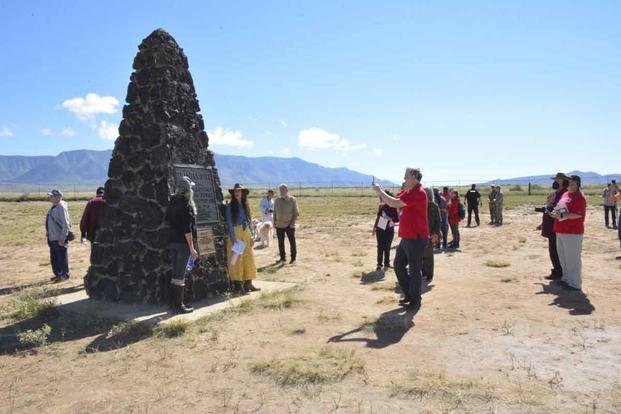
The Army has canceled the April 6 open house for the public to visit the New Mexico site of the Trinity atomic bomb blast for lack of funds following a crowd surge last October brought on by the blockbuster movie "Oppenheimer."
In a January posting, the website of the Army's White Sands Missile Range, where the world's first atomic explosion went off on July 16, 1945, said that the April open house had been canceled and will not be rescheduled "due to unforeseen circumstances" related to the range's budget.
A White Sands spokesman said Monday that costs for accommodating the public for free at the site come from discretionary funds, and the funding will not be available for April 6.
Read Next: Army Unveils Occupational Fields that Need More Soldiers -- and Bonuses to Get Them Filled
The site of the world's first test of a nuclear weapon has been open to the public for only one day in April and one day in October annually, since White Sands is still an active missile range.
The White Sands spokesman said that the next open house in October is still on schedule, but the Army is looking at the possibility of making it a paid event for the public.
The last open house on Oct. 21, 2023, was the first since the release in July 2023 of the "Oppenheimer" movie. It received several Academy Awards, including best picture, and brought about renewed interest in the personal and political travails of the theoretical physicist J. Robert Oppenheimer and the eclectic band of scientists he oversaw in the top secret effort to produce the first atomic weapons.
Ahead of the open house last October, the Army put out an advisory warning that, "due to the release of the movie 'Oppenheimer' in July, we are expecting a larger than normal crowd. You may have wait times of up to two hours getting onto the site. If you are not one of the first 5,000 visitors, you might not get through the gate prior to its closure at 2 p.m."
The movie "Oppenheimer" is controversial in New Mexico for making no mention of the "downwinders" who may have been harmed by the fallout from the Trinity blast, which was estimated to have the force of more than 24 kilotons, or 24,000 tons of TNT.
The site where the Trinity bomb, dubbed the "Gadget" by the scientists, exploded is now marked by a 12-foot tall obelisk made of black lava rock put in place in 1965 and has a metal plaque bearing the inscription: "Trinity Site Where the World's First Nuclear Device Was Exploded on July 16, 1945."
In 1975, the National Park Service added a second plaque which states: "This site possesses national significance in commemorating the history of the U.S.A."
Related: The Trinity Test Site Is Open One More Time This Year. You Might Not Get In.
Richard Sisk

You May Also Like

The Houthis claimed the assault, which comes after a period of relatively few rebel attacks on shipping in the region over...

Sgt. Colin Arslanbas, with the 24th Marine Expeditionary Unit died April 18 during a training incident in a coastal county in...

A pair of laser weapons has been deployed by the Army to an undisclosed location overseas to blast incoming enemy drones out...

Lt. Col. Eric Ackles, commander of 1st Battalion, 57th Air Defense Artillery Regiment, was relieved of command, the service...
Military News
- Investigations and Features
- Military Opinion
Select Service
- National Guard
Most Popular Military News

Col. Ben Jonsson's nomination to become a one-star general was set to expire May 1 under a law that says military officer...
Sgt. Colin Arslanbas, a Marine with the 24th Marine Expeditionary Unit, or MEU, died Thursday evening during a training...

The Transportation Security Administration's Credential Authentication Technology reads the cards' INDEF date field as...

Specialist Sanda G. Frimpong, who was serving on active duty until his arrest in 2023, was ordered to pay back over $350,000...

The Navy has convicted a chief petty officer of attempted espionage, among other charges, at a court-martial in San Diego...
Latest Benefits Info
- 4 Tips for Flying Space-A
- The Mental Burden of Using Military Benefits
- Fertility Benefits for Active-Duty Service Members
- Military Child Care Fees
- Military Tuition Assistance (TA) Overview
More Military Headlines
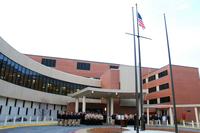
A new report finds that the system, now used at all military treatment facilities except for most dental clinics, earns low...

Nearly four years after a civilian skydiving aircraft collided with a Marine Corps MV-22 Osprey sitting on a San Diego runway...
- The Army Has Officially Deployed Laser Weapons Overseas to Combat Enemy Drones
- Fired After 6 Months: Army Sacks Commander of Germany Unit Meant to Bolster NATO Against Russia
- Small Fraction of Soldiers Experiencing Sexual Harassment Filed Complaints, Pentagon Watchdog Finds
- Nomination of Air Force Officer at Center of GOP's Fight Against 'Woke' Military Extended to 2025
- Barksdale Air Force Base Closes Dining Hall Due to 'Pest Control Issue' as Photos of Rodents Shared Online
- Black Enlisted Airmen Face Court-Martial at Much Higher Rates than White Peers, Study Finds
- $520 Million in Construction at Norfolk Naval Shipyard Aims to Meet Needs of High-Tech Warships
- Navy Chief Petty Officer Convicted of Attempted Espionage at San Diego Court-Martial
- Red Hill Community Panel Says Navy Leaving Questions Unanswered
Military Benefits Updates
- Parachute Mishap Cited as Cause of Death for Camp Lejeune Marine Who Was Training in North Carolina
- Feds Settle Case for $2 Million After Skydiving Plane Took Out Marine Corps Osprey on Runway
- Camp Lejeune Sergeant Identified as Marine Killed During Training in North Carolina
- New Coast Guard Unit Commissioned at Fort Drum
- Several Dozen Ships Lost Propulsion in Maryland Waters Before Key Bridge Collapse: 'You're Basically Just Drifting'
- Coast Guard Reopens Ohio River Near Pittsburgh to Maritime Traffic After Sunken Barge Is Found
Entertainment
- The 9 Biggest Military Dirtbags in Movies and Television
- What the ‘Fallout’ Show Gets Right About the Post-Apocalyptic Video Game Series
- Watching the Emotional 'Bluey' Episode 'The Sign' as a Military Parent
- Skip to main content
- Keyboard shortcuts for audio player

Middle East crisis — explained
The conflict between Israel and Palestinians — and other groups in the Middle East — goes back decades. These stories provide context for current developments and the history that led up to them.
Israel launches missile strikes into Iran, U.S. military official says

Rob Schmitz

Peter Kenyon

Demonstrators wave a huge Iranian flag in an anti-Israeli gathering in front of an anti-Israeli banner on the wall of a building at the Felestin (Palestine) Square in Tehran, Iran, on Monday. Vahid Salemi/AP hide caption
Demonstrators wave a huge Iranian flag in an anti-Israeli gathering in front of an anti-Israeli banner on the wall of a building at the Felestin (Palestine) Square in Tehran, Iran, on Monday.
The Israeli military has conducted missile strikes against Iran, a senior U.S. military official told NPR on Thursday. There are also reports of explosions in Iraq and Syria.
The strikes appear to be the response Israel vowed to carry out after an Iranian attack on Sunday, when Tehran fired hundreds of drones and missiles at Israel. Most of Iran's volleys were intercepted or caused little damage. The U.S. military official spoke on condition of anonymity Thursday.
The extent of Israel's strikes and the weapons used weren't clear.
Iran state news agency IRNA reported a military official in the central Iranian city of Isfahan, Brigadier General Mihan Dost, as saying loud sounds heard east of the city were the sound of air defenses intercepting what he called a "suspicious target" and that no damage was reported in the area.

What we know so far about Israel's strike on Iran — and what could happen next
Other Iranian news agencies had not reported any such strike and have concluded the sounds reported near Isfahan were the interception of one or more drones.
Israel's military and prime minister's office have not yet responded to NPR's request for comment.
The International Atomic Energy Agency has confirmed on social media that there is no damage to Iran's nuclear sites.
Meanwhile, Israel's hardline National Security Minister, Itamar Ben-Gvir, wrote on social media platform X, formerly known as Twitter, that Israel's latest apparent strike against Iran was "weak" and too limited.
Commercial flights continue in and out of Israel, and the country's Home Front Command system, which is responsible for issuing threat alerts to civilians during tense military times, didn't change its threat level.
In Iran, flights were temporarily grounded in the morning, but resumed just a couple of hours later.
The U.S. and other western allies had been urging Israel to forego a military strike to avoid a regional conflict springing out of the Israel-Hamas war .
Those concerns rose when an air strike – which Iran blamed on Israel – killed two Iranian military commanders in the country's consulate in Damascus, Syria, on April 1.

How Iran and Israel became archenemies
Iran said Sunday's attack on Israel was in response to that.
The region has been on the edge of wider conflict since Hamas attacked Israel on Oct. 7, killing 1,200 people and taking more than 240 others hostage, according to Israel. Israel's military campaign in response in Gaza has killed more than 33,000 people, according to Gaza health officials.
Israel and Iran-backed Hezbollah have traded frequent fire over the northern Israel border. Houthi militants, also backed by Iran, have been going after international commercial vessels passing through the Red Sea in recent months. The group's leaders claim they're targeting ships with links to Israel in response to the country's ongoing invasion of Gaza.

IMAGES
VIDEO
COMMENTS
LOS ALAMOS NATIONAL LABORATORY. Trinity Site is located on White Sands Missile Range and is closed to the public. On the first Saturday in April and the third Saturday in October, the US Army hosts a Trinity Site Open House when the public may visit Trinity Site. See the location of the Trinity Test, site of the first human-caused first nuclear ...
On July 16, 1945, one week after the establishment of White Sands Missile Range (WSMR), the world's first atomic bomb was detonated in the north-central portion of the missile range, approximately 60 miles north of White Sands National Park. For the Project Trinity test, the bomb was placed atop a 100-foot steel tower that was designated Zero.
When you visit the Trinity site, you can view the "Fat Man Bomb Casing." This artifact is a reconstruction of the casing that held the bomb that fell on Nagasaki. During this part of the tour, you will understand how it got its name! ... He who famously declared at the bomb's test site, "I have become death, the destroyer of worlds." ...
Trinity Site is located on White Sands Missile Range and is closed to the public. Twice a year, the US Army hosts a Trinity Site Open House when the public may visit Trinity Site. ... For the Project Trinity test, the bomb was placed atop a 100-foot (30.48 m) tall steel tower that was designated Zero. ...
The date for the upcoming Trinity Site Open House is October 19, 2024. The Alamogordo Caravan is cancelled indefinitely. WSMR employees may not use their uprange access to enter through WSMR gates to get to the Trinity Site Open House. They must enter through the Stallion Gate during 8 a.m. and 2 p.m.
The first atomic bomb sitting atop it's tower at Trinity Site. The bomb had a plutonium core that would be compressed with conventional explosives to achieve critical mass. White Sands Missile Range /
Discover Trinity Atomic Bomb Site in New Mexico: Twice a year, visitors can tour the desolate site that birthed the Atomic Age. ... To visit the Trinity Site on days when it is open to the public ...
Both roads are paved and marked. The site closes promptly at 3:30 p.m. At the site, visitors can take a quarter-mile walk to ground zero where a small obelisk marks the exact spot where the bomb ...
Twice a year, the White Sands Missile Range in New Mexico is opened to visitors seeking to view the Trinity Site, where the first atomic bomb was detonated on July 16, 1945.
The remnant of the container used to hold the first tested atomic bomb is seen as people visit during an open house on Saturday, October 15, 2022. Trinity Site opens only two Saturdays a year ...
This was a must visit for me to see the site of the world's first atomic bomb test. Trinity Site is located on the White Sands Missle Range and is only open 2 times a year to the general public. There is an obelisk at ground zero along with historical pictures around the fence. ... We plan to stay in Albuquerque and visit Trinity site on Sat ...
Trinity Site Open House. The 51,500-acre area was declared a national historic landmark in 1975. The landmark includes Base Camp, where the scientists and support group lived; Ground Zero, where the bomb was placed for the explosion; and the Schmidt/McDonald Ranch House, where the plutonium core to the bomb was assembled.
For videos of the Trinity test, visit our YouTube channel. After the War. In 1952, the site of the first atomic explosion was bulldozed and most of the trinitite removed. The site received a National Historic Landmark designation in 1965 and was listed on the Register of Historic Places less than a year later. Ground Zero at Trinity is marked ...
The words on the plaque will tell you where you are: Trinity Site — where the world's first nuclear device was exploded on July 16, 1945. Trinity has largely faded from the public ...
The first atomic bomb was tested at 5:29:45 a.m. Mountain War Time on July 16, 1945 at Trinity Site. Visit Socorro New Mexico. A Year Round Destination and Celebration of History, Technology, Birds, Art and Enchanted Skies ... Visit Socorro New Mexico Phone: (575)835-8927 email: [email protected]
Visitors flocked to the New Mexico site, where the first atomic bomb was detonated, on October 21. The Trinity Site is open to the public twice a year.
The explosion was more massive than scientists predicted. In a flash of blinding light and thunderous sound, a mushroom cloud 38,000 feet (11,582 m) tall consumed the sky. This nuclear explosion was visible over 280 miles (450 km) away. While this detonation ushered in the nuclear age, the Trinity Test exposed local people who lived near or ...
The Trinity Site is where the first nuclear bomb exploded on July 16, 1945 at 5:29 AM mountain war time. Two days out of the year there is an open house that allows the public to visit the site along with other related sites like the McDonald Ranch House.
The world was forever changed on July 16 th, 1945 at the Trinity Test Site. It was here at the White Sands Missile Range that the first atomic bomb was detonated and brought a quick end to the Second World War in the Pacific. Today it is a national historical site that is open to visitors just 2 days per year, (pending Army approval) in April ...
Published July 26, 2023. The Army said the only day for tourists to visit the Trinity nuclear test site in New Mexico this year could be packed amid the massive popularity of the blockbuster movie ...
The Trinity Site was where the first atomic bomb was tested at 5:29:45 a.m. Mountain War Time on July 16, 1945 on the White Sands Missile Range in New Mexico. ... a two-hour visit delivered a dose ...
Trinity was the code name of the first detonation of a nuclear weapon, conducted by the United States Army at 5:29 a.m. MWT (11:29:21 GMT) on July 16, 1945, as part of the Manhattan Project.The test was of an implosion-design plutonium bomb, nicknamed the "gadget", of the same design as the Fat Man bomb later detonated over Nagasaki, Japan, on August 9, 1945.
The Army has canceled the April 6 open house for the public to visit the New Mexico site of the Trinity atomic bomb blast for lack of funds following a crowd surge last October brought on by the ...
The Israeli military has conducted missile strikes against Iran, a senior U.S. military official told NPR on Thursday. There are also reports of explosions in Iraq and Syria. The strikes appear to ...